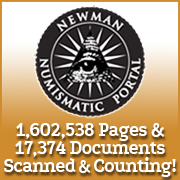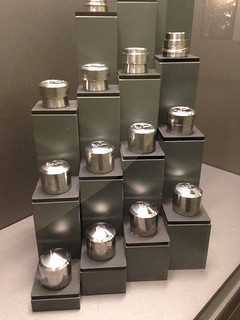
About UsThe Numismatic Bibliomania Society is a non-profit organization devoted to the study and enjoyment of numismatic literature. For more information please see our web site at coinbooks.org SubscriptionsThose wishing to become new E-Sylum subscribers (or wishing to Unsubscribe) can go to the following web page link MembershipThere is a membership application available on the web site Membership Application To join, print the application and return it with your check to the address printed on the application. Print/Digital membership is $40 to addresses in the U.S., and $60 elsewhere. A digital-only membership is available for $25. For those without web access, write to: Terry White, Treasurer AsylumFor Asylum mailing address changes and other membership questions, contact Terry at this email address: terrywhite5475@yahoo.com SubmissionsTo submit items for publication in The E-Sylum, just Reply to this message, or write to the Editor at this address: whomren@gmail.com BUY THE BOOK BEFORE THE COINSale Calendar |
- WAYNE'S WORDS: THE E-SYLUM NOVEMBER 5, 2017
- NEW BOOK: THE LATER REPUBLICAN CISTOPHORI
- NEW BOOK: ROMAN COINS IN ELIZABETHAN ENGLAND
- NEW BOOK: ISLAMIC HISTORY THROUGH COINS, 2ND ED
- NEW BOOK: CANADIAN TIRE NUMISMATIC CATALOGUE
- NEW BOOK: THE COIN DEALER KILLER
- 1871 ROBERT E. LEE MEDAL CORRECTION
- ANS MONEY TALKS: NUMISMATIC BOOK COLLECTING
- STIRLING MAXWELL’S ILLUSTRIUM IMAGINES
- ISAAC NEWTON'S PRINICIPIA MATHEMATICA
- 1890 LEACH “IN GOD WE TRUST” LETTER SCANNED
- NEWMAN PORTAL SEARCH: KAGIN-15
- NICOLE'S NEWMAN NUMISMATIC PORTAL OVERVIEW
- ANS RELEASES HIGH RESOLUTION COIN IMAGES
- ANS PARTNERS WITH GOOGLE ARTS & CULTURE
- M. L. BEISTLE'S COIN FOLDER PRODUCTS
- QUERY: WASHINGTON BEFORE BOSTON MEDAL PLASTER
- QUERY: COLONIAL-ERA TRADE TOKEN UNEARTHED
- NOTES FROM E-SYLUM READERS: NOVEMBER 5, 2017
- CONTINENTAL DOLLAR DIE VARIETY IDENTIFICATION
- READER THOUGHTS ON CONTINENTAL DOLLAR ORIGINS
- VOCABULARY TERMS: BASIN AND DIE CAMBER
- CHARLES WYATT TAINTOR (1850-1892)
- HARVEY STACK'S NUMISMATIC FAMILY, PART 3
- HARVEY STACK'S NUMISMATIC FAMILY, PART 4
- A VISIT TO THE PARIS MINT MUSEUM
- RUST COIN OFFERS MORMON COLLECTION
- NUMISMATIC NUGGETS: NOVEMBER 5, 2017
- ARABIC COINS IN MEDFORD MASSACHUSETTS 1787
- VIDEO: IN DEEP WATER: FINDING THE SS CENTRAL AMERICA
- OLD ROMAN COIN COLLECTION FOUND IN CASTLE
- BRITS RUSHED TO SPEND OLD ROUND POUND COINS
- BANK SELLS FAKE ROYAL CANADIAN MINT GOLD
- U.S. CONGRESSMEN CALL FOR ACTION ON COUNTERFEITS
- ROYAL MINT PLANS GOLD-TRACKING BLOCKCHAIN
- ARTICLES INTERVIEWS CRANE CURRENCY ENGINEER
- ANOTHER G. W. BUSH PRESIDENTIAL CHALLENGE COIN
- ARMY CAPT. GARY ROSE RECEIVES MEDAL OF HONOR
- NEW £10 NOTE HAS BRAILLE-STYLE FEATURE
- CANADA $20 BILL'S MAPLE LEAF ISN’T CANADIAN
- WOULD BREAKAWAY CATALONIA CREATE OWN CURRENCY?
- KING MIDAS STATUE COVERED IN COINS
- FEATURED WEB SITE: ROYAL MINT MUSEUM
Click here to access the complete archive
To comment or submit articles, reply to whomren@gmail.com
Content presented in The E-Sylum is not necessarily researched or independently fact-checked, and views expressed do not necessarily represent those of the Numismatic Bibliomania Society.
WAYNE'S WORDS: THE E-SYLUM NOVEMBER 5, 2017
 New subscribers this week include: Steve DeFreytas, courtesy of Peter Bertram; William Brown, Yifu Che, and a dozen others, courtesy of Frank Draskovic; and Kevin Day-Thorburn. Welcome
aboard! We now have 3,312 subscribers.
New subscribers this week include: Steve DeFreytas, courtesy of Peter Bertram; William Brown, Yifu Che, and a dozen others, courtesy of Frank Draskovic; and Kevin Day-Thorburn. Welcome
aboard! We now have 3,312 subscribers.
Thank you for reading The E-Sylum. If you enjoy it, please send me the email addresses of friends you think may enjoy it as well and I'll send them a subscription with your compliments. Contact me at whomren@gmail.com anytime regarding your subscription, or questions, comments or suggestions about our content.
Today is Guy Fawkes Day. This week we open with FIVE new books, a correction, a talk on numismatic book collecting, and two rare and important books.
Other topics this week include the In God We Trust motto, announcement from the ANS, the Washington Before Boston medal, numismatic vocabulary terms, Harvey Stack's memiors, Morman money, Arabic coins in colonial Massachusetts, and counterfeiting coins and ingots.
To learn more about Republican Cistophori, Canadian Tire money, the earliest illustrated numismatic book, M. L. Beistle's coin folder products, Continental Dollar die varieties, die camber, basining, David and Harold Proskey, the Paris Mint Museum, and the George W. Bush challenge coin, read on. Have a great week, everyone!
Wayne Homren
Editor, The E-Sylum
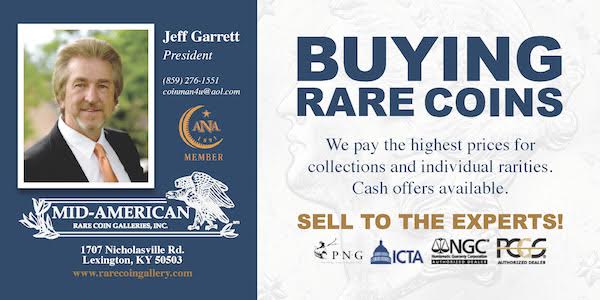
NEW BOOK: THE LATER REPUBLICAN CISTOPHORI
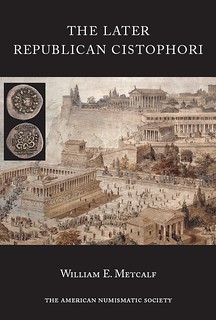 The Later Republican Cistophori
The Later Republican Cistophori
(Numismatic Notes and Monographs 170)
by William Metcalf
List price: $75 plus shipping & handling
Member price: $45 plus shipping & handling
ISSN 0078-2718
ISBN 978-0-89722-347-8
Hardcover, 230 text pages, 34 b/w figures
The Later Republican Cistophori treats the cistophoric coinage bearing the names of Roman magistrates, most commonly proconsuls, struck in 58–48 BC, as well as other issues which depart from the traditional paradigm.
The cistophori were originally introduced as the currency of the Hellenistic Attalid kingdom by the mid-second century BC. They were retained as the coins of the realm even after the kingdom was bequeathed to Rome in 133 BC and continued to be struck down into the first century BC.
The Later Republican Cistophori catalogues and illustrates some 523 cistophori and fractions from the mints of Ephesus, Pergamum, Tralles, and Apameia, as well as the ATPA series and related issues. A detailed commentary discusses the Roman magistrates and the Greek signers of their coinages as well as well as the metrology and fineness of the cistophori.
ABOUT THE AUTHOR
William E. Metcalf received his PhD from the University of Michigan (1973) and almost immediately joined the staff of the American Numismatic Society. He remained there for 27 years as curator of
Roman and Byzantine coins, and from 1979–2000 as Chief Curator. In 2002 he joined Yale University as Professor Adjunct of Classics and Curator (later Ben Lee Damsky Curator) of Coins and Medals, and
retired in 2014. In addition to Yale he has taught at Columbia, Princeton, New York, and Rutgers Universities, Bryn Mawr College, and the Università degli Studi, Padova. He has lectured widely and is
the author or editor of nine books and over 100 articles and reviews.
For more information, or to order, see:
The Later Republican Cistophori (http://numismatics.org/store/metcalf/)
NEW BOOK: ROMAN COINS IN ELIZABETHAN ENGLAND
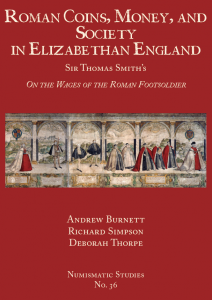 Roman Coins, Money, and Society in Elizabethan England
Roman Coins, Money, and Society in Elizabethan England
(Numismatic Studies 36)
by Richard Simpson, Andrew Burnett, and Deborah Thorpe
List price: $80 plus shipping & handling
Member price: $55 plus shipping & handling
ISSN 0517-404-x
ISBN 978-0-89722-352-2
Hardcover, 230 text pages, 34 b/w figures
The idea of publishing Sir Thomas Smith’s On the Wages of the Roman Footsoldier (OWRF) grew out of the successful conference held at the Society of Antiquaries of London in December 2013 to mark the 500th anniversary of Smith’s birth. OWRF is virtually unknown to modern scholarship, and, although it is the first original work written in England to use the evidence of ancient coins, it has previously played no part in the history of numismatics. Yet it clearly deserves to be better known, both for that reason and for many others. It throws new light on the “Cambridge circle,” the group of academics-turned-politicians who played a crucial role in the smooth accession of Elizabeth I. It allows us to reconstruct something of the humanistic interest in numismatics, adumbrated earlier in the century by Tunstall and More, but otherwise only returning to visibility with the work of Camden, Cotton, and the Elizabethan College of Antiquaries. It provides another strand to our knowledge of the importance of the Roman precedent in both influencing contemporary thought and having a direct bearing on contemporary politics.
Sir Thomas Smith, like many of his works, has also slipped from public awareness, overshadowed in the modern imagination by contemporaries like Cecil, Walsingham, or Gresham. Yet Smith was one of the most important politicians and intellectuals of the day; a brilliant academic career at Cambridge was followed by his active participation in politics under Edward VI, Mary, and Elizabeth. He played a leading role in the controversial reform of Greek pronunciation, he introduced a new style of continental architecture to England, and he wrote analyses of the politics of his day, including his views on the relations between the monarch and parliament, views which were to be seized on in the crisis of the 17th century in a way which would no doubt have startled Smith, had he lived to see it.
For this reason the publication of the OWRF is accompanied by Richard Simpson’s personal and intellectual biography of this most important of the “missing persons” of the 16th century. The biography is intended partly to remedy some of the misconceptions about Smith, but, more importantly to set OWRF and his other writings in a coherent biographical framework.
Order this title from our distributor, Casemate Academic/Oxbow Books. ANS Members, use your discount code at checkout. Forgot the code? Email Emma Pratte, or call 212.571.4470 x117.
For more information, or to order, see:
Roman Coins, Money, and Society in Elizabethan England (http://numismatics.org/store/owrf/)
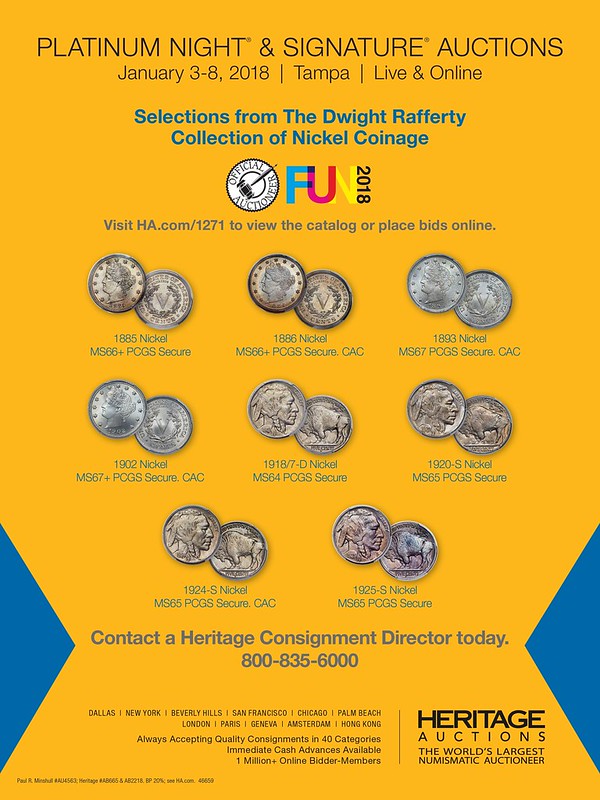
NEW BOOK: ISLAMIC HISTORY THROUGH COINS, 2ND ED
 I am very pleased to share with you the news that the American University in Cairo Press has placed the electronic, revised edition of my Islamic History through Coins: An Analysis and
Catalogue of Tenth-Century Ikhshidid Coinage, 2nd ed. (Cairo: AUC Press, 2015) on its Free e-book site at http://www.aucpress.com/t-ebooks.aspx .
I am very pleased to share with you the news that the American University in Cairo Press has placed the electronic, revised edition of my Islamic History through Coins: An Analysis and
Catalogue of Tenth-Century Ikhshidid Coinage, 2nd ed. (Cairo: AUC Press, 2015) on its Free e-book site at http://www.aucpress.com/t-ebooks.aspx .
For those not familiar with the work, the second half of the book is a catalog of all the numismatic material I could find related to the Egyptian-based dynasty and is an important tool for curators, collectors, and dealers in identifying Ikhshidid coins. The first half of the book begins with an introduction for those unfamiliar with numismatic material and ends with a discussion of tenth-century Abbasid coinage.
Chapter two details what one can learn from a study of the coins issued during the governorship of the dynasty?s founder, Muhammad ibn Tughj al-Ikhshid (323-34/935-69), including why al-Ikhshid put his honorific title (laqab) on his regular coinage and the possible reasons for the appearance of a Central Asian symbol (tamga) on a presentation piece.
Chapter three analyzes the coinage of the rest of the dynasty including how which part of a medieval Muslim name appeared on the coinage reflected the hierarchy of naming practices and where and why the name of Ka!fur, probably the most famous African eunuch in medieval Islamic history, appeared on coins struck outside Ikhshidid lands.
The second edition not only corrects errors from the first edition of 2006 but adds new data and examples. The first edition was a co-winner of the Samir Shamma Prize for the best book in Islamic Numismatics, Royal Numismatic Society of Great Britain, for 2006-07. As a free electronic book it may be useful for your own library, and for colleagues and even students, if this is an appropriate category for you.
NEW BOOK: CANADIAN TIRE NUMISMATIC CATALOGUE
 The 2017 Canadian Tire Numismatic Catalogue contains all the regular issues of notes issued by the Corporation, the Petroleum division and Simard-Montcalm. The large majority are made by
Canadian Banknote Company and British American Bank Note.
The 2017 Canadian Tire Numismatic Catalogue contains all the regular issues of notes issued by the Corporation, the Petroleum division and Simard-Montcalm. The large majority are made by
Canadian Banknote Company and British American Bank Note.
All notes issued until the end of July 2017 are included.
There are nearly 700 images describing the notes. This catalogue has a color cover, the inside is black and white and the format is 8.5” x 11” and has 144 pages.
For more information, or to order, see:
2017 Canadian Tire Numismatic Catalogue – Printed Copy
(https://ctccollector.ca/store/shop/2017-canadian-tire-numismatic-catalogue-printed-copy/)
NEW BOOK: THE COIN DEALER KILLER
 One October morning in 1979, a stamp and coin dealer was gunned down in his Visalia shop. There were no witnesses. Persistent police efforts across jurisdictional lines connected it to
another death. Two months earlier, the body of a Fresno coin dealer was found locked in the trunk of his car. The trail of evidence led to a most unlikely suspect. Author Ronn M. Couillard, retired
judge and former Visalia district attorney, lays out the facts in this compelling case from the investigation to the court proceedings and the surprise that almost derailed the conviction.
One October morning in 1979, a stamp and coin dealer was gunned down in his Visalia shop. There were no witnesses. Persistent police efforts across jurisdictional lines connected it to
another death. Two months earlier, the body of a Fresno coin dealer was found locked in the trunk of his car. The trail of evidence led to a most unlikely suspect. Author Ronn M. Couillard, retired
judge and former Visalia district attorney, lays out the facts in this compelling case from the investigation to the court proceedings and the surprise that almost derailed the conviction.
Bob adds:
It is more of a crime story than numismatic.
For more information, or to order, see:
Murder in Visalia: The Coin Dealer Killer (https://www.arcadiapublishing.com/Products/9781625859808)

1871 ROBERT E. LEE MEDAL CORRECTION
C871-114a corrective entry to appear in forthcoming
Confederate Numismatica: Supplement 1 – 2018
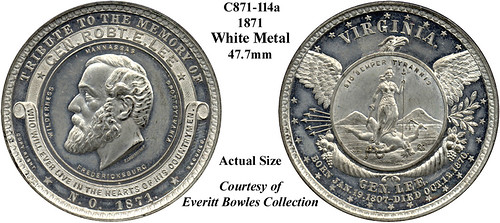
C871-114a somehow slipped by the proofreaders (yeah - including me!) and was published as “silver” in Confederate Numismatica – Part 1, page 134. This medal was produced in “White Metal” only – absolutely no silver specimens have been reported and none are known to exist. My thanks to Steve DeFreytas and my sincerest apologies to all!
Peter Bertram
peterb1861@gmail.com
www.ConfederateNumismatica.com
To read the earlier E-Sylum articles, see:
NEW BOOK: CONFEDERATE NUMISMATICA, PART 1 (http://www.coinbooks.org/esylum_v19n30a04.html)
BOOK REVIEW: CONFEDERATE NUMISMATICA (http://www.coinbooks.org/esylum_v19n31a11.html)
ANS MONEY TALKS: NUMISMATIC BOOK COLLECTING
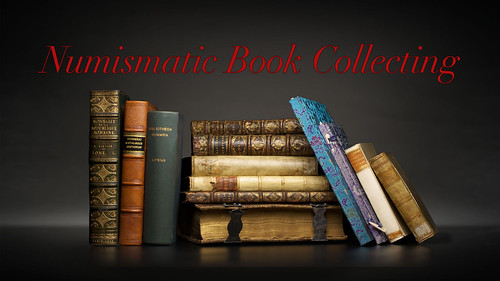
Numismatic Book Collecting
Jonathan Kagan & David Hill
November 18, 2017 | 1:00 pm – 4:00 pm
$30 for members / $50 for nonmembers
In the age of the internet, most older books, including numismatic books, are available online thanks to initiatives of the Bibliothèque de France, the Newman Numismatic Portal and many other platforms. What does this mean for collectors of physical books and other historical records? Jonathan Kagan, who has collected rare numismatic books for the last 40 years, and David Hill, archivist and librarian for the ANS, will examine the notion of collectible books and manuscripts and consider their place in private and public collections. Examples from the Kagan and ANS Libraries will be at hand for inspection.
For more information, see:
http://numismatics.org/money-talks-books/
THE BOOK BAZARRE
STIRLING MAXWELL’S ILLUSTRIUM IMAGINES
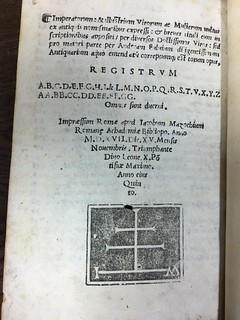 It was a very nice little reminder by Joel Orosz about Andreas Fulvio and the 500th birthday of his charming “Illustrium Imagines” in last week’s E-Sylum. I recently purchased a
really beautiful example of the second issue of Fulvio’s Renaissance gem, published on 15 November 1517. It was William Stirling Maxwell’s copy; his important library was sold by Christies, in London
in May 1958. Here is a short description of the volume currently in my stock.
It was a very nice little reminder by Joel Orosz about Andreas Fulvio and the 500th birthday of his charming “Illustrium Imagines” in last week’s E-Sylum. I recently purchased a
really beautiful example of the second issue of Fulvio’s Renaissance gem, published on 15 November 1517. It was William Stirling Maxwell’s copy; his important library was sold by Christies, in London
in May 1958. Here is a short description of the volume currently in my stock.
THE EARLIEST ILLUSTRATED NUMISMATIC BOOK - A TRUE RENAISSANCE GEM
FULVIO. Andrea. Illustrium Imagines. Rome, Jacopo Mazzocchi, 15 November, 1517. Octavo, (162 x 99mm); 120 leaves printed in italic, the majority with superb woodcut medallion portraits within ornate foliate architectural borders; title within simple woodcut border, printer’s device on final leaf; title page a fraction short; leaves K2-3 transposed. Particularly clean and fresh. Nineteenth-century polished smooth tan armorial calf, gilt, with the arms of William Stirling; expertly re-backed; speckled page edges.
This is the first book to use medallion portraits of illustrious men and women in order to provide historical illustrations and moral example. It is the second issue of the first edition - the first issue being printed just 7 days earlier, on 7 November. There are 204 medallion portraits, each 32mm to 58 mm in diameter, and each within a border, and with descriptive text below. The portraits, white on black, were long attributed to Ugo de Carpi; however, more recently they have been assigned to Giovanni Battista Palumba. There are eight different border designs, and the portraits were based on the coins in Mazzocchi’s own collection of coins and medals.
Dekesel F15
See: Cunnally. John: Images of the Illustrious. The Numismatic Presence in the Renaissance. Princeton, 1999; pp. 52-86.
See: Numismatics in the Age of Grolier. An Exhibition at the Grolier |Club, New York. 11 September- 24 November 2001, pages 18-20.
See: Illustrium Imagines incorporating an English Translation of Nota by Roberto Weisss. Accompanied by a leaf from the first illustrated numismatic book. Crestline, 2001.
Sir William Stirling-Maxwell (1818-1878) arms on binding and engraved bookplate- his sale Christie’s 20-23 May 1958
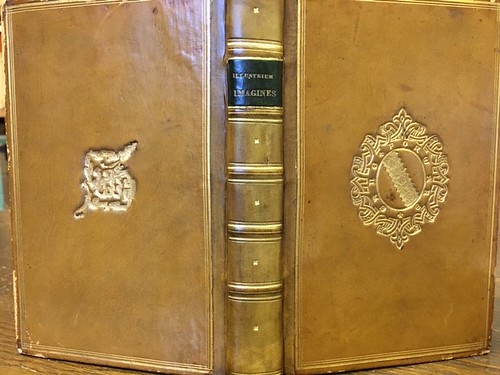
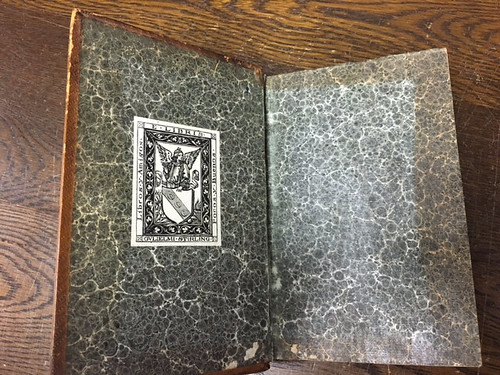
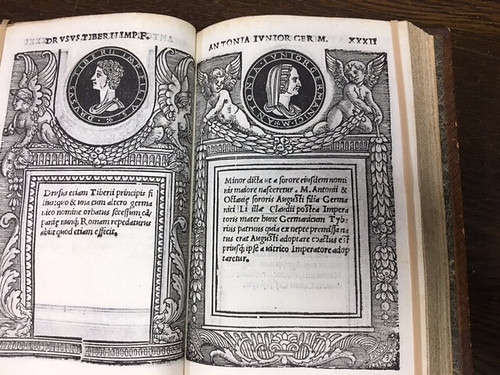
To read the earlier E-Sylum article, see:
NOTES FROM E-SYLUM READERS: OCTOBER 29, 2017: Happy Birthday, Illustrium Imagines
(http://www.coinbooks.org/v20/esylum_v20n44a12.html)
ISAAC NEWTON'S PRINICIPIA MATHEMATICA

Last month I visited the Wren Library at Trinity College in Cambridge, luckily at a time the library was open to the public, and it was a Newtonian's dream! A case was pretty much devoted to him, containing his walking stick, some of his hair, the actual prism he used to discover wavelengths and -- perfect for the bibliophile in all of us -- his personal copy of the first edition of his Prinicipia Mathematica, complete with annotations in his hand that were incorporated into the second edition. And, while you can't go in, you can at least see from the outside the room he occupied while he was at school there.
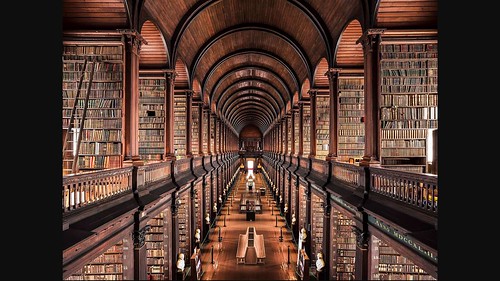
Jeff adds:
For those interested in the historical fiction genre I HIGHLY recommend Neil Stephenson's "Baroque Trilogy" which is mostly in the 16th and 17th centuries and in which Newton plays a major role. But be warned -- each book is about a thousand pages long and insanely addictive (as well as erudite, earthy and funny at the same time!).
For more information on the Wren Library, see:
WREN LIBRARY (https://www.trin.cam.ac.uk/library/wren-library/)
For more information on Newton's work at the Royal Mint, see:
Isaac Newton : Warden and then Master of the Royal Mint 1696-1727
(http://www.royalmintmuseum.org.uk/history/people/mint-officials/isaac-newton/#)
BOOK REVIEW: NEWTON AND THE COUNTERFEITER (http://www.coinbooks.org/esylum_v12n32a03.html)

1890 LEACH “IN GOD WE TRUST” LETTER SCANNED

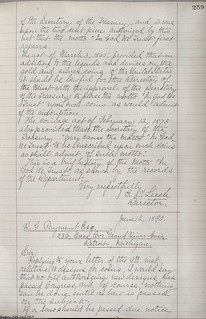
Mint Director Leech’s letter to Alabama congressman Joseph Wheeler, 6/12/1890
Mint Director Edward Leech Letter on “In God We Trust” (1890)
While scanning U.S. Mint Director correspondence for the Newman Portal, Roger W. Burdette located an 1890 letter from Director Edward Leech responding to a congressman’s inquiry on the origin of “In God We Trust” on U.S. coinage. The motto first appeared on the two-cent piece in 1864, although pattern pieces dated 1863 alternately employed GOD AND COUNTRY, GOD OUR TRUST, and IN GOD WE TRUST. The adoption of “In God We Trust” is one of the better documented design changes within United States coinage and is traced back to a November 13, 1861 letter from Rev. Mark Watkinson of Ridleyville, PA to Secretary of the Treasury Salmon Chase, urging acknowledgement of Almighty God on American coinage.
Watkinson’s original proposal was much different than that eventually adopted: “What I propose is that instead of the goddess of Liberty we shall have next inside the thirteen stars, a ring inscribed with the words perpetual union. Within this ring the all-seeing eye, crowned with a halo. Beneath this eye the American flag, bearing in its fields stars equal to the number of the States United. In the fields of the bars the words God, liberty, law.”
Instead of this busy design, legislation simply adding “In God We Trust” was passed April 22, 1864, and U.S. coinage widely adopted the motto in 1865 (smaller denominations were excepted). Thanks to Bill Bierly, who is currently writing a book on the adoption of “In God We Trust,” for supplying certain of the above information.
Link to Leech 1890 letter on Internet Archive:
https://www.archive.org/stream/RG104Entry235Vol057#page/n287/mode/2up
Link to U.S. National Archives records on Newman Portal:
https://nnp.wustl.edu/Library/Archives?searchLetter=U
NEWMAN PORTAL SEARCH: KAGIN-15

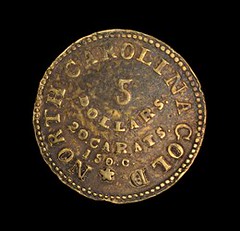
A Newman Portal user recently searched for “Kagin-15.” Having no idea what this was, we entered the search ourselves, and learned that this refers to Bechtler gold pieces as catalogued by Don Kagin. Bechtler gold was privately coined in North Carolina from 1831 and 1852, and, as examples are priced at four-figures and up, most numismatists would be satisfied with a single piece. For the specialist, Kagin has enumerated the die varieties, and this is one of the more prized. Kagin-15 is a $5 variety, with the inscription 5 / DOLLARS / 20 CARATS / 150 G.
The Newman Portal search identified three auction appearances, two from Stack’s Bowers and one from Kagin’s. The Newman Portal also contains images of Bechtler gold from the Smithsonian, and two examples of the Kagin-15 were located in that collection (one here illustrated). We would welcome attributions for the remainder of the Bechtler pieces.
Link to Bechtler gold pieces from the National Numismatic Collection on Newman Portal:
https://nnp.wustl.edu/library/imagecollection/510000

NICOLE'S NEWMAN NUMISMATIC PORTAL OVERVIEW
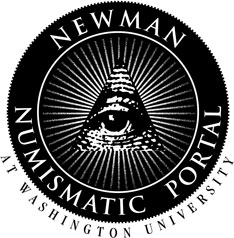 This past October, I attended the Digital Library Federation 2017 conference in Pittsburgh, Pennsylvania. This was my first time at the event. While there, I was able to learn more about
the digital humanities field and connect with others working on similar projects throughout the country. I also gave a presentation on the scanning process used to create the Newman Numismatic Portal
at Washington University in Saint Louis. Below is a partial recap of the presentation:
This past October, I attended the Digital Library Federation 2017 conference in Pittsburgh, Pennsylvania. This was my first time at the event. While there, I was able to learn more about
the digital humanities field and connect with others working on similar projects throughout the country. I also gave a presentation on the scanning process used to create the Newman Numismatic Portal
at Washington University in Saint Louis. Below is a partial recap of the presentation:
Our benefactor, Eric P. Newman, is a 106-year-old coin expert living in Saint Louis, Missouri. One of his goals in life is to make numismatic research as freely and easily available as possible. Thanks to his generosity, the Newman Numismatic Portal is rapidly becoming the most comprehensive resource for numismatic research and reference material in the world. Our initial concentration has been on United States coinage and currency, though we have begun expanding in to other English language materials. We do not handle the coins or currency, only books and paper research materials related to them.
The portal has grown quickly over the last three years. We currently have over 12,000 volumes, 10,000 auction lot listings, 3,000 biographies, and 25,000 encyclopedia records, with more added every day. To digitize our materials, we use an ATIZ overhead scanner and a Table Top Scribe scanner from Internet Archive. The bulk of our scanning is done on the Table Top Scribe machine. We have a partnership with Internet Archive so that they do our image correction, cropping, and verifying pagination and metadata for us. This helps with speed – we scan about 2,000 pages on an average a day. These documents appear on Internet Archive’s website under the WUSTL collection. They are installed in to the Newman Portal by referencing the original copy.
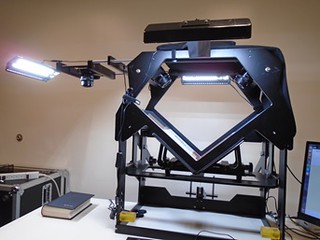 Our Table Top Scribe can comfortably scan up to 8.5 x 11 inch documents. For larger materials, we use the ATIZ, which can handle pages up to 17 x 24.5 inches. We do have to edit anything
scanned on the ATIZ in house, so the process is a bit slower. We have to get creative when scanning long foldout diagrams. For example, a student scanning assistant used Photoshop to stitch together
several four-foot long diagrams in “61st Congress, 2nd Session: 1909-1910… Financial Diagrams” (viewable here).
Our Table Top Scribe can comfortably scan up to 8.5 x 11 inch documents. For larger materials, we use the ATIZ, which can handle pages up to 17 x 24.5 inches. We do have to edit anything
scanned on the ATIZ in house, so the process is a bit slower. We have to get creative when scanning long foldout diagrams. For example, a student scanning assistant used Photoshop to stitch together
several four-foot long diagrams in “61st Congress, 2nd Session: 1909-1910… Financial Diagrams” (viewable here).
One of the major projects going on at the Saint Louis scanning center is the digitization of the Eric P. Newman correspondence. We have Newman’s numismatic correspondence from 1930 to 2014, with over 31,000 pages of an estimated 32,000 total pages online. This is the most involved project at the office, with the team processing the materials from raw. We pulled the letters from Newman’s basement (a place that is reminiscent of the final scene in the movie Raiders of the Lost Ark, with seemingly endless rows of filing cabinets). We then sorted the letters in to a more organized arrangement, pulling out rusty staples and paperclips as we went. We read each letter for content, removing any personal correspondence that accidentally made its way in. Finally, we scanned the letters on our ATIZ scanner, edited the images, and posted them in to the Newman Portal. Newman’s collection of letters are on view at nnp.wustl.edu/library/archives.
The Newman Numismatic Portal is constantly expanding. Please visit us at nnp.wustl.edu, where the most valuable thing is knowledge.
To read the complete article, see:
Newman Numismatic Portal: Building the Currency Library (https://library.wustl.edu/nnp-building-currency-library/)
ANS RELEASES HIGH RESOLUTION COIN IMAGES
The ANS is pleased to announce a new image-zooming feature in MANTIS, the online database of its numismatic collection, and ARCHER, the Society's digital archive. The ANS will now make its highest-resolution images freely available under a Creative Commons license, enabling researchers to zoom down into minute details of an object that were obscured in the lower-resolution images previously published.
More than 160,000 numismatic objects have been photographed thus far and are available in this new interface. Beyond MANTIS, the high-resolution images of Roman Republican, Imperial, and Hellenistic coins will likewise be available within their respective online type corpora projects: Coinage of the Roman Republic Online, Online Coinage of the Roman Empire, and PELLA.
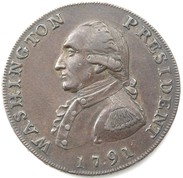
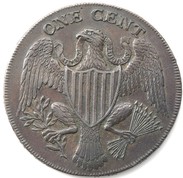
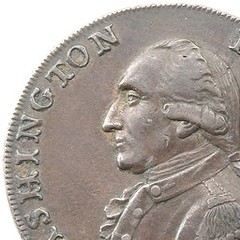
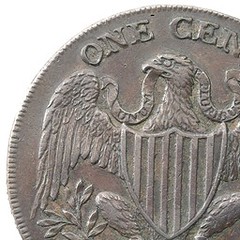
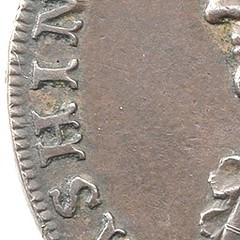
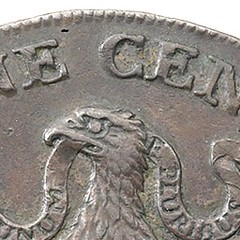
For links to the ANS online resources, see:
http://numismatics.org/resources/
Entry for the illustrated coin:
Copper cent, United States, 1783 - 1795. 0000.999.28515 (http://numismatics.org/collection/0000.999.28515)

ANS PARTNERS WITH GOOGLE ARTS & CULTURE
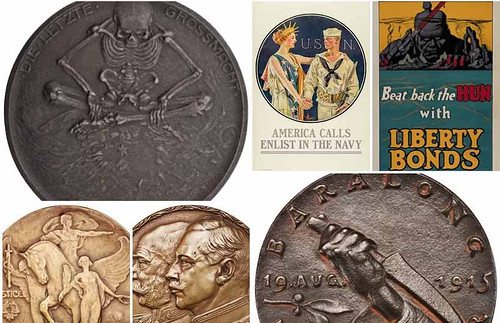
The American Numismatic Society has partnered with Google Arts & Culture to present online exhibits of its collections through the Google Cultural Institute. The Art of Devastation: Medals and Posters from the Great War marks the ANS’s first online exhibition, presented in seven sections. Featuring every medal and poster from the actual exhibit hosted at Vassar College’s Frances Lehman Loeb Art Center from January 27 until April 9, 2017, online guests can browse high-definition images, view video, engage with maps, and link directly to the ANS’s object database for more information about the items on display.
To view the ANS online exhibits (just one for now), see:
https://www.google.com/culturalinstitute/beta/partner/american-numismatic-society
M. L. BEISTLE'S COIN FOLDER PRODUCTS
Author David Lange writes:
It was nice to read of M. L. Beistle's manufacture of Halloween products, but I'm surprised that there was mention of his numismatic activity beyond his half dollar book. To study his collection while preparing this reference, he used his company's tooling to make a coin holder of his own design that would allow him to examine his halves side by side while keeping his hands free to hold a magnifier and a pencil.
After completing his manuscript and selling his primary collection of half dollars to "Colonel" E. H. R. Green, Beistle decided to market his coin holder and expand the line to include openings of many sizes. Wayte Raymond was an early customer and liked what he saw, acquiring the distribution rights to Beistle's Unique Coin Holder late in 1930. He then had Beistle create a binder for the formerly free-standing panels and renamed this ensemble the National Coin Album.
I'm attaching photos of some Beistle numismatic products, but there are many more. The company put out three commemorative medals over the years, and these are illustrated in my book about Beistle, Raymond and Meghrig coin albums.
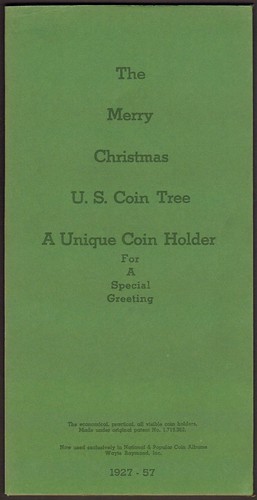
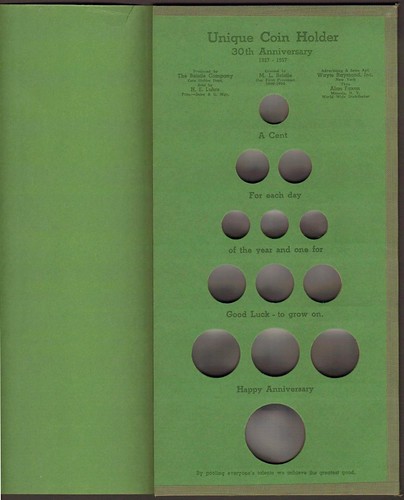
Christmas Tree Gift Coin Folder
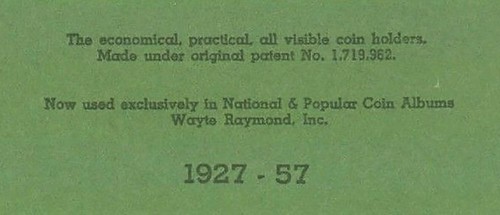
Christmas Tree Gift Coin Folder detail
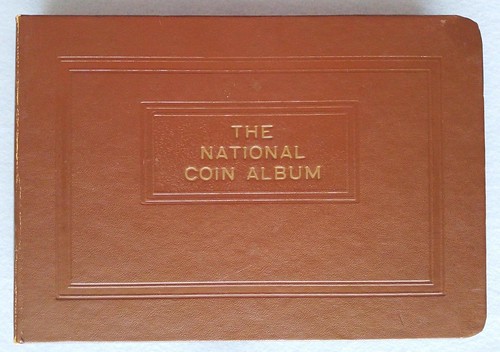
National Coin Album binder

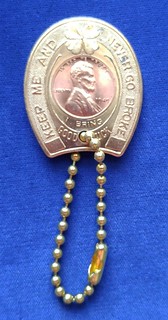
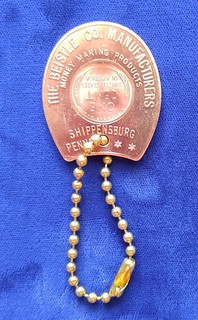
Beistle encasement
To read the earlier E-Sylum articles, see:
NEW BOOK: THE NATIONAL COIN ALBUM AND RELATED PRODUCTS (http://www.coinbooks.org/esylum_v16n41a04.html)
BOOK REVIEW: THE NATIONAL COIN ALBUM (http://www.coinbooks.org/esylum_v17n04a06.html)
HAPPY HALLOWEEN 2017 : The Beistle Company (http://www.coinbooks.org/v20/esylum_v20n44a09.html)
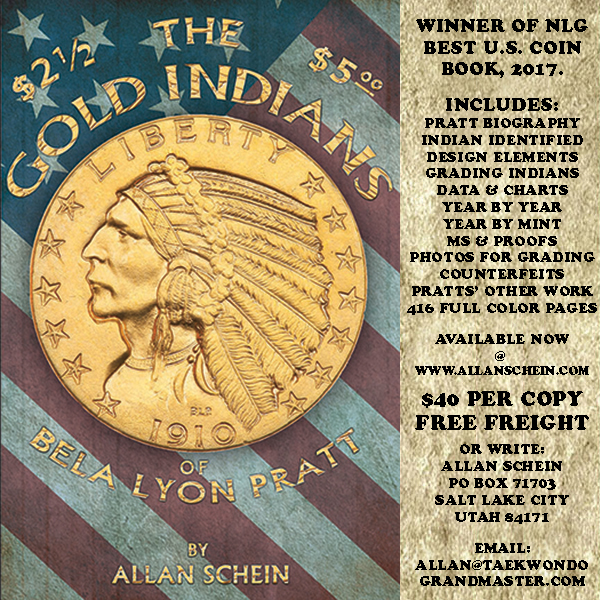
QUERY: WASHINGTON BEFORE BOSTON MEDAL PLASTER
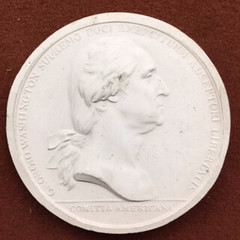
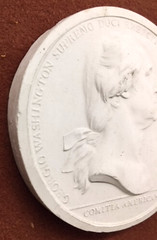
Bill Burd of Chicago writes:
A friend of mine has this plaster cast of a Washington before Boston medal. He hasn’t accurately measured it but is approximately 68 mm. He got it from a descendant of a government official. It was in an expensive old-time frame. We would like some information on it.
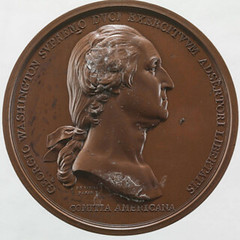

Bill adds:
Notice “EXERCITUUM “ is spelled with U instead of V. I believe that is a distinct variety.
John Adams writes:
As Mr. Burd notes, the plaster derives from a matrix that employed the original "U" die. This die was rejected for reasons discussed on page 48 of COMITIA AMERICANA AND RELATED MEDALS. Thus, it must have been prepared by a Paris Mint insider who had access to that die or to the BPL cliché referenced on the same page or to the Adams shell mentioned on page 30 . My eyes or the image are not good enough to guess how far removed the plaster is from the die or one of its emissions.
Anne Bentley writes:
I forwarded this to Neil Musante whose eyes are younger than mine and whose visual recall is far superior than mine ever was.
Neil Musante, author of Medallic Washington writes:
I think John has it 100% correct.
QUERY: COLONIAL-ERA TRADE TOKEN UNEARTHED

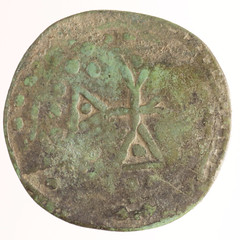
I was hoping E-Sylum readers could assist in identifying the attached item. Brian Jones, the State Archaeologist for Connecticut recently sent me the following inquiry related to an item they recently uncovered. Neither I, not any of the other members of editorial board of The Colonial Newsletter were able to make an identification. Information regarding the context of the find from Brian's e-mail to me follows:
"This summer we unearthed a peculiar probable trade token at the Oliver Ellsworth site in Windsor, Connecticut. The site was occupied first in 1635 by Francis Stiles, one of Windsor’s founders. The token has a peculiar cross form with triangular terminations with a central dot within each termination on one side and a fleur-de-lys pattern on the reverse.
I have been unable to identify it after a number of attempts online and hope you may be able to help. The token(?) came from the edge of the outer wall of a filled cellar that was partially examined this summer. The cellar (from a barn or house) could date as early as 1635 – 1640 and the associated structure appears to have been demolished before about 1740 – so the context is not perfect, but we should be in that ballpark."
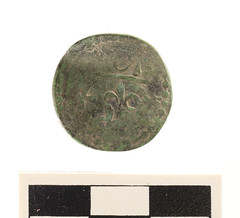
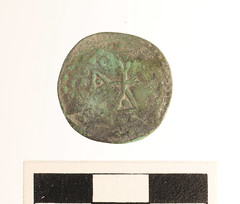
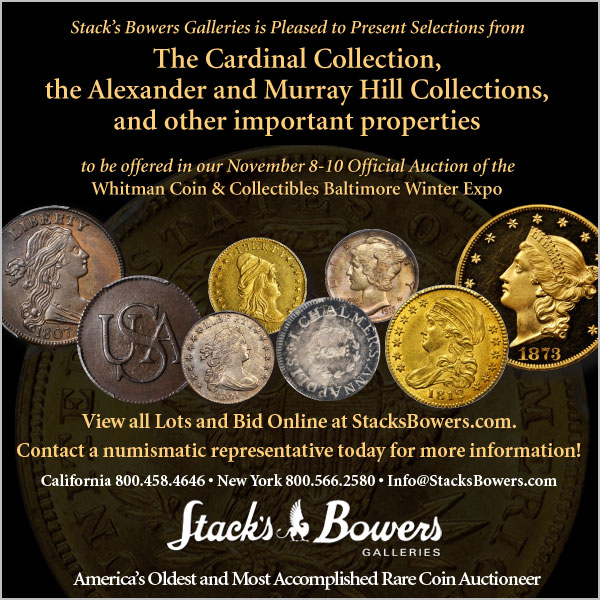
NOTES FROM E-SYLUM READERS: NOVEMBER 5, 2017
Howard Daniel Remembers Jim Fairfield
Regarding the late coin dealer Jim Fairfield of Ft. Wayne, IN, Howard Daniel of Port Saint Lucie, Florida writes:
During many springs I would leave the MPC Fest in Port Clinton, Ohio and drive down to Fort Wayne. First I would see one of my old aunts, who has since passed away, then drive to Neil Soward's old store. After going through the tokens and medals stock books, I would have a nearby lunch with two Vietnam War veteran friends of mine.
After lunch, I would go to Fairfield Rare Coins. As I walked in, I would go all the way around the coin and paper money counters and walk up to a wall display that included some Southeast Asian pieces I wanted to buy. Before I could turn around, Jim would tell me, as he did every time, "It is not for sale." I am sure Jim will be looking down at me the next time I am in his store and telling me it is still not for sale. I am already missing him.
To read the earlier E-Sylum article, see:
JAMES WINSTON FAIRFIELD (1930-2017) (http://www.coinbooks.org/v20/esylum_v20n40a07.html)
To read the full guest book, see:
JAMES W FAIRFIELD
(http://www.legacy.com/guestbook/DignityMemorial/guestbook.aspx?n=james-fairfield&pid=186483488)
More Travel Quiz Answers
Following up on our earlier "TRAVEL QUIZ", Howard Daniel adds:
The AT (and ATT) is the "cent" part of a Siamese Tical; a Thai Baht; or a Lao Kip.
The LAT is the bullion ingot for the Lao and neighboring peoples. It can be silver, silver/copper, copper/bronze or just copper. Those with a intricate design on the top are often called Tiger Tongues, which is a name created to interest tourists into buying them in Bangkok, but the design is actually taken from the back of a crocodile. Their weights are based on the Tamlung of 60 grams and are usually found in 1/4, 1/2, 3/4, 1, 1 1/4, 1 1/2, etc. Tamlung.
To read the earlier E-Sylum article, see:
TRAVEL QUIZ ANSWERS (http://www.coinbooks.org/v20/esylum_v20n39a16.html)
More on Susan Taylor's Remembrance Medal


Greg Burns writes:
I just thought I’d drop a quick note to say that after The E-Sylum ran the piece on Susan Taylor winning the American Medal of the Year for her piece “Remembrance” I had contacted her to have my name added to the list of folks interested in acquiring one. She dutifully did so, and it arrived today.
She had relayed in the interval that there were some trials and tribulations in the production process (having done a piece on the Lusitania I was familiar with such “fun”), but in the end, holding the specimen in my hands, I was quite pleased that she had persevered and produced the beautifully patinated and quite nicely done piece. Anyway, a tip of my hat to Ms. Taylor. She did a wonderful job and should be justifiably proud of the final result.
To read the earlier E-Sylum article, see:
2016 AMERICAN MEDAL OF THE YEAR NAMED (http://www.coinbooks.org/v20/esylum_v20n15a34.html)
CoinsWeekly Article on Closure of Belgian Mint
To read the CoinsWeekly article, see:
Belgian Mint ceases activities (http://www.coinsweekly.com/en/Belgian-Mint-ceases-activities/4?&id=4805)
To read the earlier E-Sylum article, see:
BRUSSELS MINT TO CLOSE (http://www.coinbooks.org/v20/esylum_v20n44a08.html)
Video: The Ideal Auction
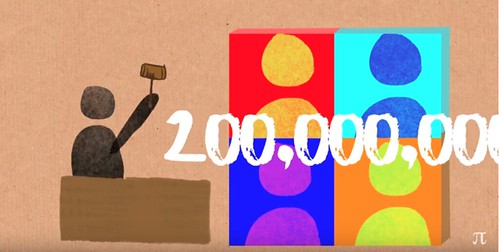
Hubert Walker writes:
I thought the readers of The E-Sylum would find this video as fascinating as I did (at least the ones who don't hold auctions on a regular basis might).
To read the earlier E-Sylum article, see:
The Ideal Auction - Numberphile (https://www.youtube.com/watch?v=4kWuxfVbIaU)
On Alternative Numismatic Terms
John Lupia writes:
I have just read last week's E-Sylum and Dick Johnson seems to have misconstrued the brief note about "center point", as if he took it personally. Now you see why I prefaced my comment "I refrained from elaborating on the alternate terms since it is quite trivial and some can be easily vexed by a presentation of a myriad of alternative terms, especially those who insist on a single term with intolerance to the use or display of others. So apologies to these sensitive readers. "
Somehow Dick takes umbrage with the statement : "Numismatic writers and catalogers should develop their own style and stick with whatever term they feel helps them and their audience understand what they wish to mean when describing a dot."
He writes, "Here’s why I disagree with that statement: If each writer or cataloger used a different term from others we have a numismatic Tower of Bable. Far better to have a form or definition accepted by all, the standard everyone will use and understand."
To use different words that mean the same thing can hardly be construed as a Tower of Babel, which, by the way, has no alternate spelling. The meaning of words are found in lexicons popularly called dictionaries in America, when they provide a pronunciation or diction key for speaking purposes, hence the name, dictionary. We will always find several words having the exact same meaning without confusing the general listener or reader. Hopefully, people will always enjoy the freedom to choose whichever word might suit them best for their purpose. One can still have a preference even when words have exactly the same meaning since the need might be for sound or its character might be thought to brighten up a phrase. It is rare we have paucity of vocabulary to choose from when wishing to say something or describe something where only a single word universally accepted and understood says it all. I doubt "center point" will ever be numbered among such exclusive terminology.
To read the earlier E-Sylum articles, see:
ALTERNATE TERMS FOR 'CENTER DOT' (http://www.coinbooks.org/v20/esylum_v20n43a08.html)
DICK JOHNSON INVITES CRITICS (http://www.coinbooks.org/v20/esylum_v20n44a16.html)
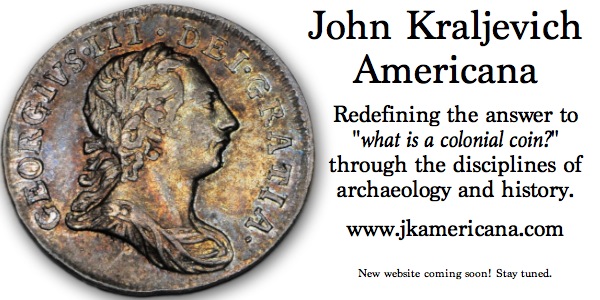
CONTINENTAL DOLLAR DIE VARIETY IDENTIFICATION
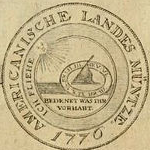
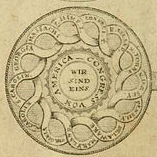
German Inscriptions in Book Illustration
In order to identify the Continental Dollar die variety in the 1784 almanac, one has to look closely. In the case of the reverse, both the 1-C and the 2-C have Massachusetts before New Hampshire in the rings so one has to view the obverse to identify the variety. With the obverse written in German, it is impossible to determine whether we are looking at a 1-C variety that used one R in currency or the 2-C variety, which uses two Rs. One has to look at the date style and then it becomes obvious. There is no question that the 1784 image is that of the Newman 2-C variety with the matching date font to the real 2-C.
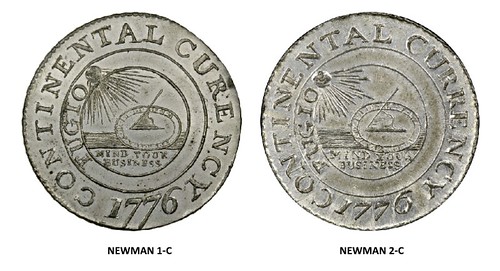
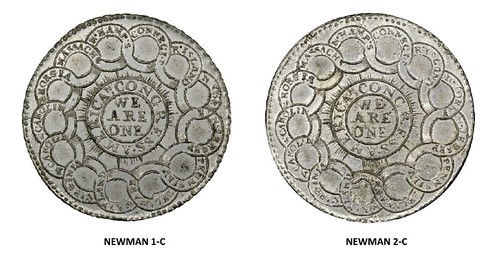
Again, there would not have been sufficient time to create a 2-C variety and then coin it to have an image example that could be sent in the timeframe required by the printer. The 2-C variety had to be in existence before the letter from the publisher requesting the images.
To read the earlier E-Sylum article, see:
ROB RODRIGUEZ ON THE CONTINENTAL DOLLARS (http://www.coinbooks.org/v20/esylum_v20n44a13.html)
READER THOUGHTS ON CONTINENTAL DOLLAR ORIGINS
David Fanning
David Fanning writes:
The ongoing discussion of the Continental Currency “dollars” has been fascinating, and Rob Rodriguez is to be congratulated for locating addition contemporary source material. A couple people have been kind enough to cite my refutation of Catherine Eagleton’s Numismatic Chronicle article, and I wanted to point out that the final version of that short article was published in the Colonial Newsletter (“A Few Notes on Catherine Eagleton’s Numismatic Chronicle Article on the Continental Dollar,” CNL, August 2015, pp. 4285-86). The version published in The E-Sylum is pretty similar, though. The item discovered and reported by Eagleton is pretty neat and could have been the basis of a good article; as it is, however, she drew far too many conclusions from far too meager evidence and introduced a couple of serious factual errors in her article that undermined her claims.
The two newspaper stories cited by Rob Rodriguez have been known for over 25 years. Philip L. Mossman, in Money of the American Colonies and Confederation [ANS, 1992], pp. 150-51, quoting AJN, Oct. 1891, p. 45, reprinted similar ones. He concluded, “These two newspaper bulletins provide no assistance in unraveling the mystery of the illusive Continental copper coin or the actual Continental Currency...” (p. 151). I concur; no such coins are known, and they do not describe Continental Dollars.
Questioning the authenticity of the ad pasted in the 1815 era catalog of the Sarah Sophia Banks collection is unjustified; this book has been in the British Museum for nearly 200 years. No duplicate has been located (I have tried) because it is not a newspaper ad, but a handbill with no printing on the verso.
The key timeline for the Continental Dollar is:
1783 (Sept. 3) - The Treaty of Paris ends the Revolutionary War, recognizing American Independence.
1783 (Late in year) - First illustration of a Continental Dollar (with German legends) appears in Leipzig.
1783? - Medal commemorating the Treaty of Paris issued, same size and metal as Continental Dollar, with similar reverse.
1783 or 1784 - Pierre Eugene Du Simitiere notes, "a Coin the size of a Crown with devices and mottos taken from the continental paper money, Struckt in London on Type-Metal, and dated 1776." Du Simitiere, the leading American numismatist of his day, lived in Philadelphia continuously from 1774 to 1784 and knew John Adams and John Jay; he was certainly in the best position to know whether Continental Dollars were struck in America or not.
1784 (Oct.) - Pierre Eugene Du Simitiere dies without publishing his knowledge of the origin of the Continental Dollar.
Circa 1785 - Richard Watson, Bishop of London, is shown a Continental Dollar; he describes it in Chemical Essays, Vol. IV, 1786.
1789 (Jan. 1) - The Independent Chronicle and the Universal Advertiser, in response to Chemical Essays, denies that there ever was such a coin as the Continental Dollar.
1789 or before - avid coin collector Sarah Sophia Banks of London acquires a Continental Dollar, Newman 3-D.
1789 (-91?) - Jonas Carlsson Dryander, librarian to Sir Joseph Banks, President of the Royal Society, notes in the first catalog of the Banks collection, "Congress Dollar. 1776, never current, struck on speculation in Europe, for sale in America." Unfortunately, this remark is not published until 2015.
1790 (Feb. 21) – Paul Revere wrote to Bishop Watson, "as for pewter money struck in America, I never saw any, and I have made carefull (sic) inquiry."
Circa 1815 - Sarah Sophia Banks completes a second catalog of her collection. Dryander's note is copied verbatim, and below it a handbill is pasted in offering "American MEDALS at Six-Pence Each," describing Continental Dollar Newman 3-D. To make any money at a price of sixpence, the seller must have had hundreds, maybe a thousand, on hand--about equal to all the survivors of Phase Two known.
My Conclusion: Continental Dollars were first illustrated in Europe (1783) and first described in London (1786). Pierre Eugène Du Simitière (1783/84) wrote that they were struck in London, and Jonas Carlsson Dryander (circa 1789) noted that they were struck in Europe. They are not mentioned in the journals of the Continental Congress, and the editor of Independent Chronicle and the Universal Advertiser (1789) wrote that they did not even exist, while Paul Revere, after careful inquiry, wrote that they were not to be seen in America (1790). Some Continental Dollars have ornamental edges, a technology known in Europe but unavailable in America in 1776. Continental Dollars must have been made in Europe late in 1783, after the signing of the Treaty of Paris, though perhaps some were restruck later.
To read the earlier E-Sylum article, see:
ROB RODRIGUEZ ON THE CONTINENTAL DOLLARS (http://www.coinbooks.org/v20/esylum_v20n44a13.html)

VOCABULARY TERMS: BASIN AND DIE CAMBER
Basin. The concaveness or sloping surface of a model, die or coined item. A die in this shape is said to have a CAMBER. The basin is formed by the rim and the DISHED
area of relief. Coin models particularly are so shaped because of the requirement of a rim higher than any point on the relief and the fact coins are struck from a single blow. A slightly curved die
face aids in the release of the coin after it is struck and one die is retracting. If the die face was flat it would cause the coin to “hang up” in the die. The pressure of striking causes the coin
to adhere to the upper die. A BACKGROUND PLATE in this dished shape is also called a “basin.” Should the design be flat without any concaveness certain modern diecutting pantographs can create a
basin shape and cut a die with a camber. The St-Gaudens 1907 $20 Gold ultrahigh relief is the most dramatic U.S. coin with a basin. See DIE CAMBER.
CLASS 03.4
REFERENCE: C70 {2017} Sholey (Craig) Nineteenth Century Medal Making Processes MCA Advisory 20:5 (September / October 2017) p 29-32.
Die Camber. A slightly domed or convex curvature of the table or background in a die. The die is purposefully domed so it may strike coins that are slightly concaved or basin shaped. The reason is that this camber will lower all relief below that of all the rim, thus with all design lower than the rim, it will reduce wear on the design while the coin is in circulation. The rim bears the brunt of all surface wear (until the rim itself is worn down to the level of the design).
Placing the camber in the die is intentional. It is often so slight that it is hardly noticeable to the human eye. Some mints require their artists to model a design on a basin-shaped background plate to create this camber in the model. Numismatic writer Walter Breen called the creating of die camber basining and described it as “imparting variable radius of curvature to the fields.”
However, with the modern die-engraving pantograph, particularly the JANVIER, a die can be cut with a camber from a flat pattern. Thus the die, hub or master die can be made with the desired camber from a flat model or pattern on a modern PANTOGRAPH. The total surface – device and lettering in addition to the fields – is lowered, ever so slightly near the rim, gradually increasing towards the CENTER POINT.
It is impossible to know how the basin shape was created on a coined piece by inspection alone (unless the coined surface is badly buckled by sinking). This condition may have resulted from any of the following: (1) use of an intended basin-shaped model, (2) die camber created by the pantograph, or (3) sinking in a worn die.
Die camber is different from a CONE BLANK or DOME BLANK which is the contour of a die prior to its being hubbed. It is also different from a BUCKLED DIE, or SUNKEN DIE, in old or worn dies.
Sinking occurs in all dies ever so slowly from constant compaction during striking (badly sunken dies strike pieces with an irregular DOMED EFFECT).
CLASS 04.4
REFERENCE:
NC10 {1988} Breen, ENCYCLOPEDIA, p 524-525.
Note: Where possible I have decided to run several terms of related meaning at one time. Otherwise it will take many years (70 in fact) to publish the entire encyclopedia list one word per week at a time. You can read any term without cost on the Newman Portal (go to Encyclopedia – then Dictionary). For those who would like to have the printed draft on hand of all 4,154 terms I still have a few copies of the printed draft at $50 each. Contact Dick Johnson, 139 Thompson Dr, Torrington, CT 06790 dick.johnson@snet.net
Looking for the meaning of a numismatic word, or the description of a term? Try the Newman Numismatic Portal's Numismatic Dictionary at: https://nnp.wustl.edu/library/dictionary
CHARLES WYATT TAINTOR (1850-1892)
Charles Wyatt Taintor (1850-1892), was born the third of seven children on November 29, 1850, at Hartford, Connecticut, son of Charles Michael Taintor (1817-1905), and Mary Lord Taintor (1822-1883). In 1855 he is listed living with his family in the home of his grandfather Charles Taintor (1787-1864), a native of Orford, New Hampshire...
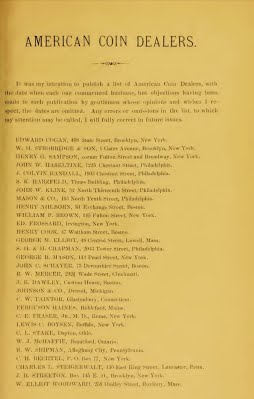 C. W. Taintor, Glastonbury, Connecticut, is listed among the "Coin Dealers" by William Elliot Woodward in his coin auction catalogue of March 31 through April 2, 1879, in his list
appended at the end of the sale.
C. W. Taintor, Glastonbury, Connecticut, is listed among the "Coin Dealers" by William Elliot Woodward in his coin auction catalogue of March 31 through April 2, 1879, in his list
appended at the end of the sale.
Among Taintor's clients were the Babb Brothers are completely unknown to American numismatic history. They do have significance to that history since they collected coins and kept them in cases and apparently purchased coins from Charles Wyatt Taintor. The Babb Brothers are Welsh. They came to America about 1870 and their activity gives us a window to view the activity of coin collectors in America in the first decade of the coin collecting explosion.
Taintor is listed in the 1891 Manchester City Directory as a second-hand book dealer.
He died on January 4, 1892.
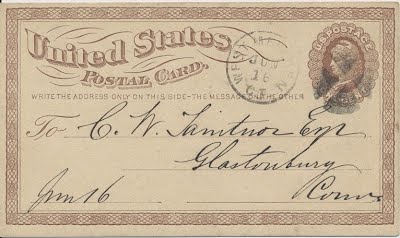

Postal Card sent by William Henry Babb (1840-1905) to his friend and coin dealer Charles Wyatt Taintnor (correctly spelled Taintor), Glastonbury, Connecticut, postmarked June 16, 1873, West Meriden, Connecticut. "
My Brother has gone to Europe for a trip and will not return till 6th of August Your "Coins" just received are in my possession. If you wish them previous to his return I will send them [to] you on application. He would have been glad of them before he went as he took a case with him."
To read the complete article, see:
TAINTOR, CHARLES WYATT
(https://sites.google.com/a/numismaticmall.com/www/numismaticmall-com/taintor-charles-wyatt)
The entire inventory of the Lupia Numismatic Library is for sale. Individual items will be available before the remaining archives are broken up into parcels sold at philatelic auctions in the U. S. and Hong Kong. Check NumismaticMall.com frequently as dozens of new items with estimates will be posted daily until everything is sold.
All inquiries will be given prompt and courteous attention. Write to: john@numismaticmall.com .

HARVEY STACK'S NUMISMATIC FAMILY, PART 3
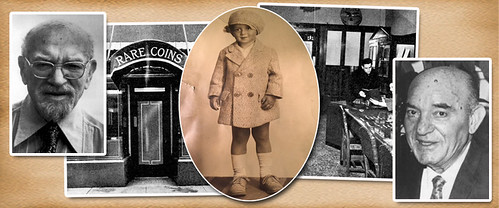
I had the opportunity once or twice to meet Col. E.H.R. Green. He would visit Stack's, usually on Saturday. A huge limousine would arrive at the door, and a huge man (at least he seemed huge to me) got out with the help of his chauffeur, walked into the shop using a beautiful walking cane with a gold and silver handle, and sat down in the shop. In anticipation of his visit each weekend, Morton and Joe would set up a few trays of gold coins from the United States and around the world. These would be items they had acquired during the week, or that had been left with them on consignment by collectors of jewelers. After the usual greetings, Col. Green would ask, " So brothers, what do you have that is new?" Morton and Joe would carry out the trays they had prepared for his visit, and set them before him. Col. Green would examine each coin, hold some in his hands to get a better view, ask about the stories of the pieces, the importance of a date or mint, and then the prices for certain rare or scarce coins.
Then, typically, Col. Green would ask: "How much for all the coins on these trays?" Morton and Joe, knowing that this question was coming, had already calculated the asking price and would quote a number. Col Green would look back at the trays and shout, "SOLD!" He would then shake hands with the Stack's brothers. One time when I was there, he even offered his hand to me. He shook my hand, patted me on the back and said "Someday you may be selling what I am buying, so keep learning about the coins. If I ever decide to sell them, I will remember you, young man." He would then ask his driver to come in, take all the trays and load them into the car. Col. Green would leave, usually with a smile on his face. Morton and Joe knew that the following Monday, the driver would return, bringing with him the trays he had carried out the Saturday before (now empty), as well as a check for the full amount of the sale.
The 1930s were years of growth at Stack's, especially once the firm became dedicated to numismatics. Morton and Joe met many collectors and dealers and the store became not only a place to buy and sell (if people had the funds), but also a place to visit and talk about coins of interest.
One of the great friendships that grew from these visits was with Harold Proskey, son of the late David Proskey a famous numismatist and hobbyist of the early 20th century (who passed away in 1928, the year I was born). Harold (Hal to his friends) Proskey was the executor of the estate of his late father. Since David Proskey had stamps, rare stones, tokens, medals, and coins from all over the world, minerals and other small collectibles, Hal decided to sell off parts of the holdings but retained the numismatic portion. He liked the coins the most and felt they had precious metal value.
Late in 1933 Hal first visited Stack's. Morton and Joe remembered his father and the other collectors of his generation and reminiscing led to fast friendship. Hal started to visit Stack's once or twice a week, bringing with him a selection of coins -- some were just change, others were Mint State or Proof, and some were entire rolls.
Stack's bought them all, and the firm was able to develop a wonderful expanded inventory. With these additions of ancient, foreign and United States coins in all metals, the inventory grew and grew. This wide selection appealed to those who were once again building their collections as the Depression lessened, and they flocked to Stack's to see what was new. So Stack's attracted many from all around New York and became a very popular place to visit. Collectors would gather in the shop, talk about coins, and buy and sell items. Even before 1935 the shop on Sixth Avenue became "The Numismatic Club House"!
To read the complete article, see: Growing up in a Numismatic Family Part 3 (http://www.stacksbowers.com/News/Pages/Blogs.aspx?ArticleID=2714)
HARVEY STACK'S NUMISMATIC FAMILY, PART 4

In 1935 Stack's held our first public auction. Before this many collections nationwide were sold in mail bid sales. But, as Stack's was right in Manhattan, the business had the benefits of being close to transportation as well as being a fairly easy trip for a great number of collectors. These included not only those in the boroughs of the city of New York and the surrounding counties, but also those who lived from Boston to Baltimore. Many would travel to the "Big City" to attend a public auction and this turned out to be a great way to attract and sell consignments along with extra store inventory.
Stack's public auction business grew in popularity and attendance once we got underway in 1935. One of our early consignors, at least from 1935 to 1938 was Hal Proskey, David Proskey's son, who saw the advantages of selling at public auction and favored Stack's with his consignments. Within the first few years Stack's had almost two dozen sales. These were attended by active collectors and dealers who enjoyed coming to the sales, buying what they could, and also meeting with friends. So popular were the early sales that many small dealers took advantage of our sales to offer their coins and currency to the public.
Morton (my father) and my uncle Joseph were constantly pursuing consignments. In fact, selling coins through public auctions became so popular that it attracted the attention of the American Numismatic Association (ANA) who had planned a convention in New York in 1939. New York City was selected that year because the World's Fair was to be held there, and the ANA figured that the convention would attract more collectors.
Stack's proposed to the ANA that they add an attraction to the convention: a public auction. They agreed, and Stack's was chosen to hold the sale. This was the first public auction to be held in conjunction with an ANA convention.
It went well. Large numbers of collectors came to the 1939 convention, because of three factors: it was a national convention in a great city, the World's Fair was happening at the same time, and there was an auction to attract even more numismatists.
The convention took place at the famous Pennsylvania Hotel, on 8th Avenue, directly across the street from the Pennsylvania Railroad Station. This station had trains going from New York to all parts of the country, dominated by the services they offered from New England to the southern states, and west to the Mississippi River. Everyone who traveled a distance used the train, as no airplanes were in use then to any extent. So, collectors came by train, walked across the street to the Pennsylvania Hotel, and were there for the ANA convention. It was a natural opportunity for Stack's and the company took advantage of it. The first ANA Convention auction was a great success and the tradition has continued ever since.
To read the complete article, see:
Growing up in a Numismatic Family Part 4 (http://www.stacksbowers.com/News/Pages/Blogs.aspx?ArticleID=2732)
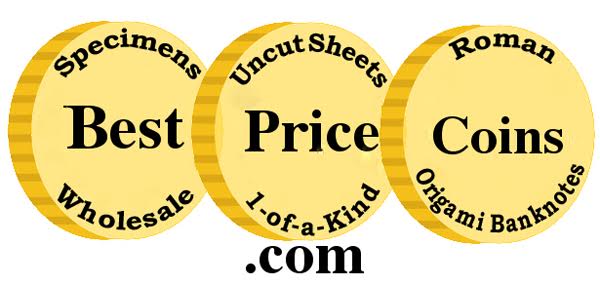
A VISIT TO THE PARIS MINT MUSEUM
The Paris Mint Museum — Monnaie de Paris — has re-opened after a major restoration from 2011 to 2017 with impressive results. Just a short walk along the Seine from the Notre Dame Cathedral, it is well worth a visit, with 10€ admission.
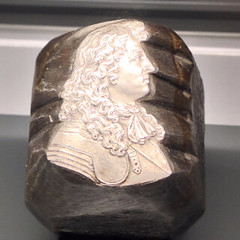
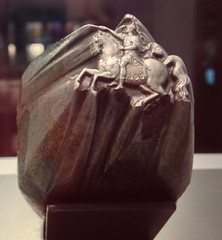
Ever since 1775, this mint in the heart of Paris, has struck gold and silver coins. Today’s euro coins are produced at a huge new mint in southwestern France. Two large modern presses remain at this mint to produce specialty items.
Some of its rooms are actually vaults with massive doors to protect the variety of numismatic items collected from around the world. Old fly presses, panographic lathes and other devices are well displayed.
I was particularly struck by the artistry of the hubs, those substantial punches used in making dies for coins and medals two or three centuries ago. So much so, I am working on a article on that particular aspect of coining history. I was impressed with a display of dies tracing the 14 steps taken as a hub or master die is gradually impressed into a die blank — with starts with a conical face! Note the blank die in the lower left of the photo.
The historical hubs were amazing. Chunks of steel the size of yams were carved down to just a particular image to be punched into a die. The images at the pointy end of the heavy punch is a
perfect representation of a 17th century horse and rider, king or other figure.
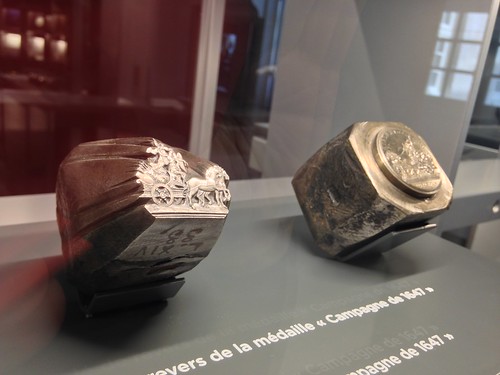
The mint’s website will tell you in just slightly fractured English: “those coins are manufactured with the same rigor and quality according to the rules of French excellence. Thanks to their state-of-the-art know-how, our creative craftsmen shape medals, awards, decorations, castings and jewelry.” The website only briefly “From the metals transformation to the finished products, these steps will guide the public to the crafts, and to the Monnaie de Paris’ historical collections, which for the most part, never had been disclosed before. These factory activities in the very heart of Paris reveal: casting, striking, die cutting as well as engraving, chiseling and gilding.
“The Grand Monnayage and the Petits Monnayages will return to their initial purpose: striking coins and medals. Seven modern presses in the Grand Monnayage and six in the lateral coin striking rooms allow the visitors to see the medals and coins made before their eyes.” Well, at least from a distance, and not on the weekends, it would seem. (I was there on a Saturday just as it opened at 11 a.m.)
“Having precisely calibrated their machine, the minters check the quality of the strike between each pass. They must detect the slightest flaw with the naked eye, understanding how the metal rises in relation to the desired relief. The air in the press is filtered and pressurized to eliminate anything which could give the coins a grainy surface. The struck motif must be perfect! The minter's craft requires a lengthy training period of about a year, during which seasoned artisans pass on their skills and knowledge.”
To read earlier E-Sylum articles, see:
MONNAIE DE PARIS RENOVATIONS COMPLETE (http://www.coinbooks.org/v20/esylum_v20n40a23.html)
MORE ON THE RENOVATED MONNAIE DE PARIS (http://www.coinbooks.org/v20/esylum_v20n42a20.html)
RUST COIN OFFERS MORMON COLLECTION
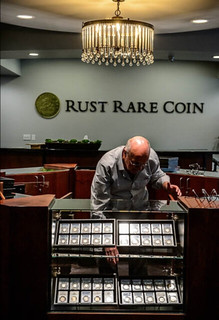 Josh Rust has seen exciting collections before, but nothing quite like this: 500 to 600 pieces of historical currency, including early Mormon bills and coins, worth an estimated $1.5
million.
Josh Rust has seen exciting collections before, but nothing quite like this: 500 to 600 pieces of historical currency, including early Mormon bills and coins, worth an estimated $1.5
million.
“There’s just a wide variety of things,” Rust said. “Money was issued by Mormons before they made it to Salt Lake, and then things that were issued once they were in Salt Lake.”
The collection will be displayed and sold at the Rust Rare Coin showroom in downtown Salt Lake City starting Friday after an invitation-only event Thursday night for private collectors and customers.
The collection came from a father and son based in Utah who have built it up over 40 years. It’s being sold by Rust Rare Coin on an outright sale and consignment basis.
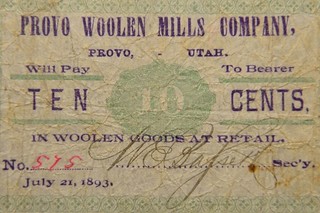
Because of the scarcity of U.S. money in the West in the 1840s through the 1890s, Rust explained, Mormon pioneers and settlers often created their own bills and notes to exchange for goods and services.
Rust said early Mormon currency was often not uniform with value backed by livestock and was accepted only in certain regional areas, but was a “known commodity.”
Among the collection is a Kirtland Note worth an estimated $32,000. Before the Mormons arrived in Salt Lake City, some pioneer leaders set up the Kirtland Safety Society Anti-Banking Co. in the 1830s in Ohio to issue their own currency.
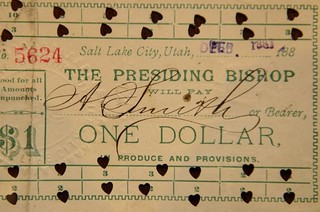
“A lot of those notes that were issued are now collectible and sought after,” Rust said. “They were a part of that Mormon history and carry signatures from Joseph Smith and Sidney Rigdon and other prominent Mormon pioneer members.”
To read the complete article, see:
Hundreds of rare Mormon coins and bills sold privately in downtown
Salt Lake City (http://www.sltrib.com/news/2017/11/03/hundreds-of-rare-mormon-coins-and-bills-sold-privately-in-downtown-salt-lake-city/)

NUMISMATIC NUGGETS: NOVEMBER 5, 2017
1825 Convict Token
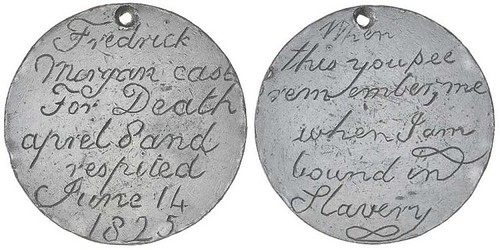
Description: Convict token, 1825, being a shaved Great Britain 1797 cartwheel penny size coin, inscribed on one side, 'Fredrick/Morgan cast/For Death/april 8 and/respited/June 14/1825', and on the other side, 'When/this you see/remember, me/when I am/bound in/Slavery'. Holed near edge for wearing, very fine and rare.
To read the complete lot description, see:
Lot 654: Australian Historical Medals (https://www.invaluable.com/auction-lot/-1-c-D1348689CF)
To read earlier E-Sylum articles, see:
CONVICT LOVE TOKENS? (http://www.coinbooks.org/esylum_v06n33a10.html)
CONVICT LOVE TOKEN BOOK AVAILABLE (http://www.coinbooks.org/esylum_v06n37a04.html)
Table Mountain-Aerial Cableway Token
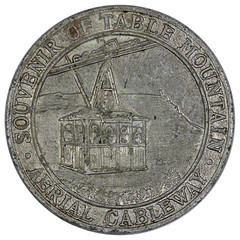
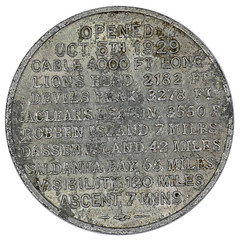
To read the complete lot description, see:
Lot 101: South Africa. 'Souvenir of Table Mountain-Aerial Cableway', VF with some surface corrosion
(https://www.invaluable.com/auction-lot/-1-c-9A1460DA19)
CIA Intelligence Star For Valor


You are bidding on a CIA Intelligence Star For Valor Medallion / Medal Name Plate blank Approx 3" in very good condition with a few minor scratches and a blank name plate. Comes with a letter signed by Gen. Colin Powell & William Webster (CIA Director)?.? We have blacked out the name of the recipient on the photos.
To read the complete lot description, see:
RARE CIA Star For Valor Medal Approx 3" w/Letter signed C. POWELL & W. WEBSTER (https://www.ebay.com/itm/372122544294)

ARABIC COINS IN MEDFORD MASSACHUSETTS 1787
John Lupia writes:
I wish to congratulate James Bailey for finding a late 17th century Arabic coin in Rhode Island and for his wonderful research and article in The Colonial Newsletter. I thought I had paid for the subscription to CNL as I always do when renewing at the ANS. Somehow I guess it fell between the proverbial cracks and I do not seem to be receiving it. I wish I had this issue since I too have a piece on a discovery of a hoard of Arabic coins in Medford, Massachusetts in 1787.
Anyway, I wish I had known about Mr. Bailey's research years ago since I had some useful information I wanted to publish but, sadly, deleted it from my manuscript American Numismatic Auctions, as entry No. 40. since it was not a coin auction and merely a splendid curiosity for this late period in colonial history.
I do not know if any of what I had been working on is found in the work of Mr. Bailey, but if none of it overlaps all the better. I hope readers will find this useful.
“DORCHESTER, NOV 5, 1808
DEAR SIR:—Permit me, through you, to make the following communication to the American Academy of Arts and Sciences.
In the spring of the year 1787, as going from Cambridge to Maiden, I passed some people at work on the highway in Medford, who, in widening the road, had removed a large flat stone, under which they found a number of square copper coins, to the quantity, I should judge, of about two quarts. I took several of them myself, and on my return, mentioned the discovery to several of my friends, who procured more.
I had hoped that a circumstance so curious would have attracted more attention, and that some learned antiquarian would have communicated to the public his observations upon the coin. As this has not been done, and lest the fact itself should be quite forgotten, I make this statement.
The coins were mostly square, but some of them of the shape and size of Fig. 15. The others are represented in Fig. 16. Fig. 17 is the same magnified, with the exergue and the characters completed by a comparison of several coins, on which the stamp was more regular and central.
They all bear the same stamp, on thin copper plate, cut, or rather broken into square pieces, with rough edges, and are considerably corroded by rust.
I have searched all the books of coins and medals in the College Library, but can find none which contain any in the least resembling these. There is, however, in the "Histori-Geographical Description of Russia, Siberia, and Great Tartary, by Philip John Von Strahlenburg," page 406, Tab. XXI, letter A, the figure of a coin, which I have copied, Fig. 18, in size, shape, and impression so similar, as to demand some attention. He says, that " it was found in Great Tartary," that " the characters were presented to the public as a great rarity, by M. Bandelot," and that the print and description of it was first published in the German tongue, in a book entitled "Das eroeffnete Ritter Platz, (ine andern Theil des geoeffneten Antiquitaten Zimmers,") page 76.
If America was first peopled by emigrants from Siberia and Tartary, as may be inferred from the square and circular ramparts and conical sepulchral mounds, scattered through the whole Western Territory down to Mexico and Peru, exactly similar in form, dimensions and content, to those described by M. Pallas and other travellers into the northern parts of the Russian empire, raised by nations no longer known there, and evidences of their having inhabited and traversed regions now become immense forests; and from inscriptions on rocks on the banks of the Ohio, and at Taunton, very like to those on the Jenesei, delineated by Strahlenburg; may we not trace this ancient coin to the same source? But this I leave to further investigation, and subscribe myself with much respect,
Your friend and humble servant,
THADDEUS MASON HARRIS” 1
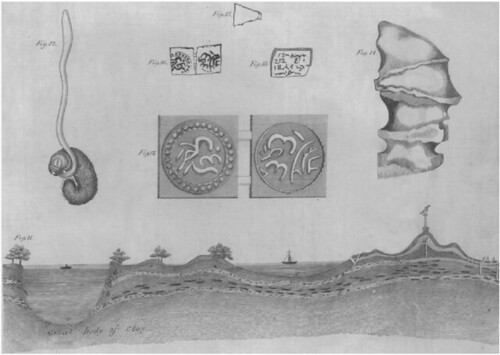
The book cited by Morris is that of Philipp Johann von Strahlenberg (1676-1747), An Historico-Geographical Description of The North And Eastern Parts of Europe And Asia : But More Particularly of Russia, Siberia, And Great Tartary : Both In Their Ancient And Modern State : Together With An Entire New Polyglot-Table of The Dialects of 32 Tartarian Nations And A Vocabulary of The Kalmuck-Mungalian Tongue. (London, Printed for J. Brotherton, J. Hazard, W. Meadows, T. Cox, T. Astley, S. Austen, L. Gilliver, and C. Corbet, 1738)
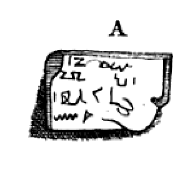
The illustration of the medal on Tab. XXI, letter A
Medford was first settled in 1630 as part of Charlestown (Boston).
“March 5, 1787, the town voted, “That Benjamin Hall, Esq., Gen. John Brooks, and Thomas Brooks, Esq., be a Committee to petition the Court of Sessions to obtain a new road through a part of Col.
Royall’s and Capt. Nicholson’s farms.” this was never obtained.”
Charles Brooks, History of the Town of Medford, Middlesex County, Massachusetts, From its First Settlement, in 1630, to the Present Time, 1855. (Boston: James M. Usher, 1855) : 54
“After the completion of the Charlestown Bridge some of the gentlemen interested became identified with a project to build a bridge from Charlestown Neck to the Malden shore near Sweetser's Point. Thomas Russell, Richard Devens, Samuel Swan, Junior, Jonathan Simpson and William Tudor, were granted by the legislature this privilege, 11 March, 1787.” 2
Although the Court of Sessions did not grant the easements through the two farms the widening of the road that already existed was undertaken as Rev. Thaddeus Mason Harris recollected. In March 1787 a hoard of copper coins were discovered buried under a flat stone. Perhaps the widening of the road was associated with the construction of the bridge “from Charlestown Neck to the Malden shore near Sweetser's Point, also begun in March 1787.”
The drawings of the copper coin differ from that published by Strahlenberg in Tab. XXI, letter A and Morris’ supposed copy. He did not copy this plate with exactitude leaving us to surmise that he also did not render the discovery coins in the copper exactly as they appeared. Furthermore, Morris tells us that the basis of the drawing of the coin and its inscription has “the characters completed by a comparison of several coins”. Since Morris did not know what he was looking at and was unfamiliar with this alphabet and could not read the inscription or recognize it the drawing he rendered most probably deviates from the original. The inscription certainly looks Arabic and not Siberian, Russian, or from the Tartary as Morris suggested. The square shapes of the coins found suggest hammered copper mintage with the wedge shaped pieces being fractions cut from a whole coin. 3 The accountability for Islamic coins in Medford, Massachusetts is not as puzzling as it at first appears. There are at least six salient solutions to this seemingly insoluble find.
First, there has been proposed an Arab Pre-Columbian transatlantic landing at a port in North America by an Asian scholar Hui-lin Li. 4 Although this is tenable it is not the exclusive explanation for the discovery of Arab coins in Medford deposited there before 1787. 5
Second, in 1695, infamous pirate captain Henry Evory or Avery (1659-1696), sometimes known as John Avery (perhaps his alias) of Plymouth, England captured an Arab Mughal merchant ship Ganj-i- sawai. This was a villainous act that put England’s mercantile relations with the Mughals in peril. Avery captured £600,000 in precious metals and jewels, making him both the most infamous and the richest pirate in the world. He and his crew fled to the Bahamas since a bounty of £1,000 was on their heads by the English crown. Some of the crew went into the British colonies of North America bringing their coins into New England.
Third, the British guinea was introduced in 1663 as a gold coin, whose name is derived from Guinea in West Africa. England imported the gold from Guinea to mint these coins by the African Company. England and Spain were the dominant traders in the Arab countries of North Africa at this time.
Fourth, we have the English and North African trade. The influences of social interactions between England and the Ottomans in North African region developed cultural changes in artist expression in the form of Orientalizing in what is known as Turquerie.
“In the early sixteenth century, there were more Englishman living in Muslim North Africa than Massachusetts and Virginia together. England had signed a trade treaty with Morocco in 1580, there was a Muslim community in London and Plymouth, and it was not unusual for Englishmen to “turn Turk” and take up residence in North Africa in the service of some Muslim potentate, even converting to Islam. The Caribbean trade triangle is familiar to most students of colonial history, but it is not generally known that ”the most dominant triangle linked England to Moorish North Africa and North America.” 6
The Levant Company chartered in 1581 regulated trade between England and Turkey and the Levant. Four members of the Levant Company were also members of the Massachusetts Bay Company. Barbary Ducats were hand hammered square gold coins with Arabic inscriptions on both sides. These were traded with the English and also circulated in trade among the British colonies of North America. These ducats were traded with the more popularly known so- called Arabian Chequin or Sequin. A table of current coins published on May 4, 1784 gives the New England value for a Chequin at 14s d. Since Arabian coins circulated it is equally possible that not only gold specie but silver and copper as well also entered into transactions not listed in the table of May 4,1784.
Fifth, the English pilgrims who arrived in British North America to establish colonies and the later immigrants that followed were not exclusively English by heritage but in some cases merely by nationality having become Anglophonic and their names Anglicized to blend and to some extent homogenized into English culture. Among these English pilgrims were Jews from the diaspora and Moors from those regions in which the English traded.
”As LaBarre observes, and contrary to popular belief, most of the Massachusetts Bay colonists made no claim of being Puritans or religious adherents of any shape, sort or fashion. They had simply immigrated to make their fortunes in the New World. The Hutchinson family, for example, traded with the West Indies through their cousin, Peleg Sanford of Rhode Island. Other Boston-based merchants traded with the crypto-Jewish strongholds of Bilbao, Portugal, Malaga, Spain and the Marrano communities of the Canaries, Madeira and Fayal. Some had factors at converso-laden Nevis, Barbados, Antigua and Guadalupe for trading in rum, wine and sugar. By 1645 Boston vessels were transporting African slaves to Barbados for the sugar plantations. And by 1664 a man named John Leverette, bearing a Hebrew surname was governor of the colony, which in the meantime had outgrown and now overshadowed the earlier Plymouth Colony, leaving Massachusetts dominated politically and ideologically by Boston and its merchants.” 7
The English name Alger is Anglicization from the Moorish for Algeria referring to a person’s place of origin. Among the Massachusetts Bay settlers was one man named Andrew Alger. The Jews from Algeria, for example, were employed there as minters of coins including copper.
“We have very few details of Jewish life in Algeria from the 16th and 17th centuries, only what we have gleaned from the writings of missionaries, diplomats and European travelers made captive by the Algerian pirates. According to these writings, one can deduce that the Jews were mainly tradesmen, jewelers or tailors. They were responsible for minting coins of copper, silver and gold.” 8
Sixth, since Boston engaged with trade among the Arabic speaking regions of the world long before 1787 any number of explanations could account for these copper coins with Arabic inscriptions being deposited in Medford. In 1655, Abraham Browne (1630-) was held for ransom by the Barbary pirates. 9 The New England family name or surname Browne refers to his dark complexion signifying he was either Jewish or Moorish. 10 In 1778 Morocco invited the United States to enter into a peace treaty. 11 This concern prompted John Adams to advise the President of the Congress in a letter dated September 10, 1783, to negotiate a peace treaty with Morocco, Algeria, Tunis and Tripoli. 12 On October 11, 1784, Moroccan Barbary pirates seized the 300-ton brig, i.e., the American Brigantine Betsey. 13 This ship sailed from Boston to Tenerife Island, one of the seven Canary Islands off the coast of North-West Africa and was captured by the “Barbary Pirates” and held for ransom.
1 Memoirs of the American Academy of Arts and Sciences, Vol. III., No. I (1809) :195-196. Reprinted in American Journal of Numismatics, Volume IV, April (1872) : 79-80. See also Thaddeus Mason Harris, The Journal of a Tour into the Territory Northwest of the Alleghany Mountains; Made in the Spring of the Year 1803 (Boston, 1805): 153, where he discusses finding plates of copper in some mounds thought to be parts of armor.
2 The Medford Historical Register, Volume X, No. 1, January (1907) : 41
3 For a study on square Arab coins see H. Edmund Hohertz, Catalog of Square Islamic Coins of Spain, Portugal and North Africa 1130-1816 A.D. (Wooster Book Co., 2008)
4 Hui-lin Li, (1960–1961). "Mu-lan-p'i: A Case for Pre-Columbian Transatlantic Travel by Arab Ships," Harvard Journal of Asiatic Studies, Volume 23 (1960-1961) : 114-126
5 Needham and Ronan see the possibility of landing but not of a return. Joseph Needham and Colin A Ronan, The Shorter Science and Civilization in China (Cambridge University Press, 1986) : 120
6 Elizabeth Caldwell Hirschman and Donald N. Yates, Jews and Muslims in British Colonial America: A Genealogical History (McFarland Publishers, 2012) : 68
7 Caldwell and Yates, Jews and Muslims, 66
8 Sarah Taieb-Carlen, The Jews of North Africa from Dido to De Gaulle (University Press of America, 2010) : 32
9 Stephen T. Riley, “Abraham Browne’s Captivity by the Barbary Pirates, 1655,” Seafaring in Colonial Massachusetts (Boston: Colonial Society, 1980) : 31-42
10 Caldwell and Yates, Jews and Muslims, 67
11 Gregory Fremont-Barnes, The Wars of the Barbary Pirates. To the Shores of Tripoli: the Rise of the US Navy and Marines. (Osprey Publishing, 2006) : 13
12 Gardner Weld Allen, Our Navy and the Barbary Corsairs (Boston: Houghton, Mifflin & Co., 1905) : 28- 29
13 Michael B. Oren, Power, Faith, and Fantasy: America in the Middle East: 1776 to the Present (W. W. Norton & Company, 2010) : 22; Robert Battistini, “Glimpses of the Other Before Orientalism: The Muslim World in Early American Periodicals, 1785-1800,” Early American Studies: An Interdisciplinary Journal, Volume 8, No. 2 (2010): 446-474
To read the earlier E-Sylum articles, see:
QUERY: YEMENI COINS IN COLONIAL AMERICA (http://www.coinbooks.org/esylum_v19n33a15.html)
COLONIAL NEWSLETTER AUGUST 2017 ISSUE PUBLISHED (http://www.coinbooks.org/v20/esylum_v20n44a03.html)
THE BOOK BAZARRE
VIDEO: IN DEEP WATER: FINDING THE SS CENTRAL AMERICA
The 1857 wreck of the S.S. Central America yielded a fabulous trove of gold coins and bars. The key organizer of the expedition was a scientist named Tommy Thompson, who much later faced charges relating to the disappearance of souvenir coins minted with salvaged gold. Thompson became a fugitive who was sought by the U.S. Marshalls office. Someone who has been following the case against Thompson writes:
I recently found the below link regarding Tommy Thompson. Apparently this was filmed in December 2014, a month before he was arrested in Florida. It is approximately 20 minutes long and was done by ESPN films. I thought your readers might be interested in it.
Signals: In Deep Water Once upon a time, the SS Central America, a side wheel steamer with a cache of gold aboard, sank during a storm in 1857. Years later a group of men used library research, Bayesian theory and underwater technology to find the ship.
He gathered data, evaluated it, adjusted it for important factors, combined it togehter, and with the use of math and statistics narrowed down the field where searchers should look for the remains of the vessel. Author Gary Kinder is interviewed as well - his 1999 Ship of Gold in the Deep Blue Sea is a fascinating account of the successful effort to find the ship's wreckage and salvage its treasure including thousands of gold coins and bars. Here are some still shots. -Editor
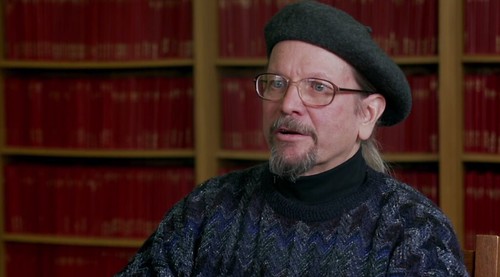
Bob Evans
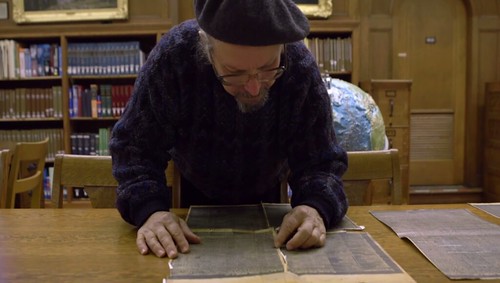
Reading Old Newspaper Accounts

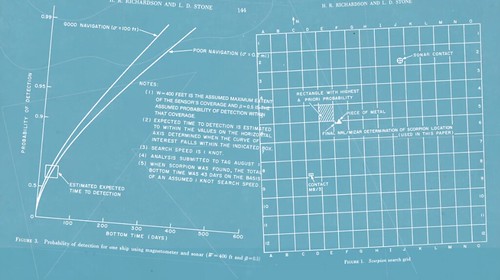
To watch the complete video, see:
Signals: In Deep Water (http://www.espn.com/video/clip?id=12834923)
A court-appointed receiver has asked a Franklin County judge to approve the sale of $30 million of gold brought up from the SS Central America shipwreck to help satisfy claims of creditors and investors.
The 16,000 artifacts recovered in 2014 by the Odyssey Marine Exploration’s dive on the 1857 wreck off the Carolina coast include gold dust, coins and bullion. An original estimate had placed the value at $47 million.
Ira O. Kane, the receiver representing Recovery Limited Partnership and Columbus Exploration LLC, filed a motion Oct. 24 with Franklin County Common Pleas Judge Laurel Beatty-Blunt asking her to approve the agreement. The judge will hold a hearing for “any interested party” at 9 a.m. Nov. 30.
Kane has an agreement to sell the gold to California Gold Marketing Group LLC, which will sell the gold for cash.
To read the complete article, see:
Sunken gold from shipwreck could be sold
(http://www.dispatch.com/news/20171101/sunken-gold-from-shipwreck-could-be-sold)
To read earlier E-Sylum articles, see:
SS CENTRAL AMERICA SALVAGE: THEN AND NOW (http://www.coinbooks.org/esylum_v17n45a08.html)
THE SS CENTRAL AMERICA TREASURE AND THE HUNT FOR TOMMY THOMPSON (http://www.coinbooks.org/esylum_v15n35a11.html)
LATEST SS CENTRAL AMERICA FINDS REVEALED (http://www.coinbooks.org/esylum_v17n30a05.html)
OLD ROMAN COIN COLLECTION FOUND IN CASTLE
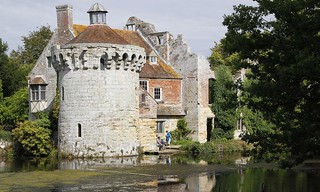 In proper storybook style, in a disintegrating cardboard box shoved to the very back of a drawer, in a castle where every nook and cranny is still stuffed with the possessions of
generations of hoarding owners, a cache of valuable antique coins, some extremely rare, has been discovered.
In proper storybook style, in a disintegrating cardboard box shoved to the very back of a drawer, in a castle where every nook and cranny is still stuffed with the possessions of
generations of hoarding owners, a cache of valuable antique coins, some extremely rare, has been discovered.
Scotney Castle in Kent was left to the National Trust in 1970, and the gardens, with the ruin of a medieval moated manor house, Scotney Old Castle, have been enjoyed by visitors since then. But the Victorian mansion house, sometimes known as New Scotney Castle, only opened to the public in 2007 after the death of Betty Hussey, the last resident of the family that owned the estate since the 18th century. Since then volunteers have been scouring through attics and cellars, and opening hundreds of cupboards and drawers, carefully recording myriad family possessions from medieval documents to 20th-century account books.
The coins are the most exciting discovery so far. Most of the 186 coins are Roman, probably collected by the Victorian owner of Scotney Castle, Edward Hussey, and his son Edwy. But they range from a silver coin showing a sea turtle, made in the seventh century BC for the tiny Greek island of Aegina, to an 18th-century Welsh token, and just one forgery, a 19th-century fake of a rare coin for the Roman emperor Otho, who reigned for just three months until he killed himself in AD 69.
The fake helped identify the probable collector: in 1823 Edward’s teenage diaries carefully recorded spending between four and seven shillings on coins. He also wrote that he wanted to collect the coins of all the Roman emperors, and when the hobby was taken up in turn by his son, they almost achieved it: only two are missing from the first and second century emperors. In 1883 they were still absorbed by their hobby: Edwy’s diary records he “went to the British Museum with papa as he wanted to ask about some coins”.
Nathalie Cohen, a National Trust archaeologist, says going through every nook and cranny of the castle has been excavation rather than housekeeping, and is intrigued that Edward also wrote that he wanted to collect the coins of all the English kings and queens: “That collection might still be somewhere in the house too, just waiting for us to find it.”
To read the complete article, see:
Cache of antique coins found in drawer at Scotney Castle
(https://www.theguardian.com/culture/2017/nov/03/cache-of-antique-coins-found-in-drawer-at-scotney-castle)
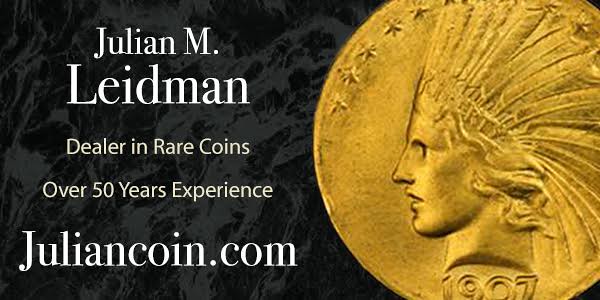
BRITS RUSHED TO SPEND OLD ROUND POUND COINS
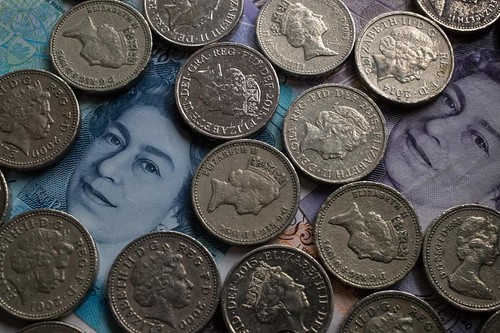
Brits have just hours left to spend their old round £1 coins as hundreds of millions of the old pounds are estimated to still be in circulation.
As of midnight on Sunday, the old pound coin will no longer be legal tender, replaced by the new design which was launched in March.
Some stores, including Tesco, have pledged to let people continue spending their round pounds for a limited period of extra time, despite the Royal Mint’s deadline of tonight.
On Saturday, it was estimated around 400 to 450 million old round coins are still lying around unspent. People had been offloading their old coins at a rate of around 60 million a week in the lead up to tonight’s deadline.
Major banks and building societies have said they will continue to accept deposits of the old round pound after the deadline on Sunday October 15.
One pound coins were first launched on April 21 1983 to replace £1 notes. The Royal Mint has produced more than two billion round pound coins since that time.
The new 12-sided pound coin, which resembles the old threepenny bit, entered circulation in March and boasts new high-tech security features to thwart counterfeiters.
The production of the new coins follows concerns about round pounds being vulnerable to sophisticated counterfeiters. Around one in every 30 old-style pound coins in people's change in recent years has been fake.
On October 24th David added:
Shops still seem to be accepting round pounds. Some people are giving them to charity.
To read the complete article, see:
Old £1 coin: Hours left to spend round pound as
'hundreds of millions' are still in circulation
(https://www.standard.co.uk/news/uk/old-1-coin-hours-left-to-spend-round-pound-as-hundreds-of-millions-still-in-circulation-a3658936.html)
UNREDEEMED BRITISH POUND COINS
The October 15th deadline came and passed. Citizens of the UK were required to turn in their old one-pound round coin to be replaced by the new 12-sided bimetallic, lettered edge, one pound coin. But 450 million still remain in the public hands.
It was estimated one in ten of the old round one pound coins in circulation were counterfeit. The British Royal Mint spent months creating a coin that was as nearly counterfeit proof as they could devise. They were first launched on April 21, 1983 to replace green £1 notes and since then two billion have been produced.
In addition to its 12 sides with edge lettering and two color bimetallic composition, it bares a hologram where the pound sign morphs into a figure 1 with a slight tilt. It also has micro letters just inside the rim on each side.
Describing the composition's term "bimetallic" is somewhat of a misnomer. Both are base metal copper nickel just the finish is different with the queen in gold color brass finish, the ring in copper nickel gray. Having both the center plug and the outer ring in copper nickel utilizes the metal recycled from melting the old one pound coins. A brilliant move in scrap technology as the old one pound coins were entirely copper nickel.
Citizens were supposed to spend their old one-pound coins before October 15 or deposit in a bank or other institution. The unspent coins now have no legal status, but they are still being accepted by banks at full value, and even some merchants attempting to increase sales.
Because of its value, the one-pound coin is different from the one penny when that coin was demonetized in 1970. Entrepreneur Bob Bashlow bought hundreds of thousands and imported these into the US. He sold these to collectors as singles, sets and sets in Whitman albums.
However the world collector market cannot absorb but a tiny amount of those 450 million unredeemed British old pound coins
To read the complete article, see:
Deadline on old pound coins extended by High Street stores as 450 million still in use
(http://www.mirror.co.uk/money/deadline-old-pound-coins-extended-11337991)
BANK SELLS FAKE ROYAL CANADIAN MINT GOLD
The Royal Canadian Mint says a phoney gold bar sold to a jeweller by an Ottawa bank may have looked like the real thing, but it was actually a counterfeit.
Spokesman Alex Reeves says the small gold wafer wasn’t made or sold by the Mint, although it was made to look like the real thing.
RBC is investigating how the fake bullion came to be sold.
The jeweller who bought the bar told a news outlet that his goldsmith knew something was wrong when he tried to put the wafer through a mill and found it was much too hard and brittle to be gold.
“We know that its purity is not four nines, its weight is not four nines,” he said. “The packaging has errors on it, so we knew right away that there were several things wrong with it. It could not possibly come from the Royal Canadian Mint.”
He said it’s rare for such a counterfeit to turn up.
“This is not widespread; this is a very isolated case,” Reeves said. “It didn’t come from the Mint, it’s not one of our bars. It imitates one of our bars, but that’s the extent of it unfortunately.”
It is up to the bank to investigate the problem, he said.
To read the complete article, see:
Ottawa bank sells counterfeit gold bar to jeweller
(https://globalnews.ca/news/3833439/ottawa-bank-sells-counterfeit-gold-bar-jeweller/)
But despite the mint's claim that counterfeits are rare, a quick internet search shows such products abound.
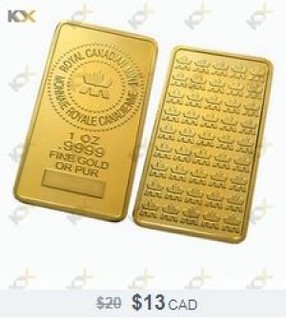 For example, the online retailer Wish.com offers what it describes as a "Canadian Gold Bar 1 OZ .9999 Premium Gold" for a price of $13 plus shipping.
For example, the online retailer Wish.com offers what it describes as a "Canadian Gold Bar 1 OZ .9999 Premium Gold" for a price of $13 plus shipping.
The bar shown also bears the stamp of the Royal Canadian Mint.
"It boils down to product knowledge," said veteran coin collector Sean Isaacs. "And the first line of defence is knowing what you're dealing with."
Calling it a "critical, frontline tool" for the bullion and coin dealer, Isaacs said he paid about $1,100 for his Sigma Metalytics precious metal verifier.
The verifier works by analyzing the conductivity of precious metals such as silver and gold.
Isaacs said a reliable verifier is something every bank dealing in precious metals should have on hand.
"The average teller at a bank I don't think has the training to recognize those [counterfeit] products, which is why, in my opinion, you either need a tool to allow you to do that, or the product knowledge to know what you're handling."
To read the complete article, see:
Fake gold not ours, mint says
(http://www.cbc.ca/news/canada/ottawa/fake-gold-not-ours-mint-says-1.4380705)

U.S. CONGRESSMEN CALL FOR ACTION ON COUNTERFEITS
Congressmen Alex Mooney (R-WV) and Frank Lucas (R-OK) today delivered a formal letter to the United States Mint and Secret Service, urging aggressive action on the growing problem of high-quality counterfeits of U.S. precious metals coins entering the country from China and elsewhere.
“Enclosed herewith is a 1995 1 oz. Gold American Eagle coin, carrying a face value $50 and ostensibly minted by the U.S. Mint,” Mooney and Lucas wrote. “You are free to keep it, as it’s a worthless tungsten fake.”
As members of the House Financial Services subcommittee which oversees the U.S. Mint, Congressmen Mooney and Lucas are seeking information from the government institution responsible for the production of coinage for the United States, such as “the nature and quantity of complaints – and resulting investigations – regarding counterfeit U.S. gold, silver, and platinum coins within the last two years,” and “what anti-counterfeiting programs, if any, are in place to protect the integrity of U.S. coins minted specifically of gold, silver, platinum, and palladium.”
The congressmen request information as to whether, and to what extent, the U.S. Mint has taken proactive steps to protect the integrity of America’s minted coins, including reviewing and implementing the anti-counterfeiting measures already put in place certain foreign government and private mints.
To read the complete article, see:
Congressmen press the U.S Mint for action on counterfeit gold and
silver coins (http://www.dcpresswire.com/2017/10/27/congressmen-press-the-u-s-mint-for-action-on-counterfeit-gold-and-silver-coins/)
I don't know if any of these events have been coordinated or inspired by the Industry Council for Tangible Assets' Anti-Counterfeiting Task Force; sometimes it's best not to inquire about the sausage-making process. But it's encouraging to see some high-level attention being paid to these issues. The next article describes one solution being explored by the U.K.'s Royal Mint. -Editor
To read earlier E-Sylum articles, see:
ANTI-COUNTERFEITING TASK FORCE ADDS WORK GROUPS (http://www.coinbooks.org/v20/esylum_v20n40a25.html)
SENATORS QUIZ MINT DIRECTOR CANDIDATE DAVID RYDER (http://www.coinbooks.org/v20/esylum_v20n44a07.html)
ROYAL MINT PLANS GOLD-TRACKING BLOCKCHAIN
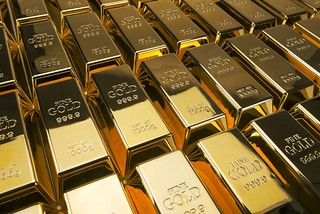 You wouldn't think you'd lose a 1kg gold bar worth more than $40,000.
You wouldn't think you'd lose a 1kg gold bar worth more than $40,000.
But during the London Blockchain Summit this week, Nicola Robinson, senior strategic marketing manager at the U.K.'s Royal Mint, which owns 5.4 percent of the global bullion market, did just that.
Sure, Robinson had handed the bar over to audience members (it was eventually recovered), but the stunt was designed to give a sense of the difficulty inherent in tracking and managing gold, and to set up how a blockchain might relieve some of that.
While the blockchain can't, obviously, store the physical gold, it has – through the group's Royal Mint Gold (RMG) blockchain – proved helpful in managing the ownership of the commodity.
Originally revealed in November 2016 as a way to provide a reliable record of gold ownership and the near instantaneous sale of the precious metal...
And while the blockchain – which was created in partnership with financial market giant CME Group using wallet startup BitGo's technology – is not yet open to the public, it has currently verified more than 50,000 blocks, Robinson said.
In her eyes, the blockchain could help manage smaller amounts (such as a single ounce) of gold, which some believe would lower the barrier to entry for potential gold investors and increase the liquidity of the market.
Robinson also used her talk at the blockchain event to hint at the Royal Mint's broader initiatives.
For one, she revealed that the launch of a blockchain-based bullion trading platform was imminent. And touched on the fact that the RMG platform could someday be used to accommodate requests to prove the provenance of gold and, even more broadly, in the provisioning of collateral of global trades.
To read the complete article, see:
Britain's Royal Mint Reveals Details on 'Live' Blockchain for Tracking
Gold (https://www.coindesk.com/britains-royal-mint-reveals-details-on-live-blockchain-for-tracking-gold/)
ARTICLES INTERVIEWS CRANE CURRENCY ENGINEER
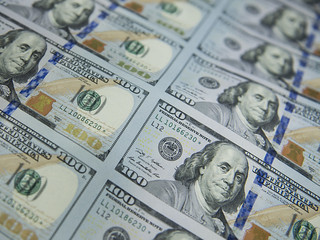 In 2005, shortly after earning a master's degree in electrical and computer engineering, Sam Cape was looking for work online when he came across a cryptic help wanted ad.
In 2005, shortly after earning a master's degree in electrical and computer engineering, Sam Cape was looking for work online when he came across a cryptic help wanted ad.
At his interview, he was shown something that blew his mind. Cape says it looked like film but was three-dimensional and appeared to be moving. It was in fact a prototype of a micro-optics technology he would go on to refine as the director of research and development for Massachusetts-based Crane Currency.
Crane's history dates to the American Revolution. When Paul Revere prepared to take his famous midnight ride to warn of the approach of the British, he stabled his horses at a paper mill owned by Stephen Crane, who was also a freedom fighter. When the War of Independence broke out, Revere engraved the first printing plates, and Crane supplied the paper for the bank notes used to pay soldiers.
In 1879, Crane won a contract from the U.S. Bureau of Engraving and Printing to produce the paper for federal bank notes, which it has been doing ever since. The company's motion technology has been woven into every $100 bill since 2013.
Cape says the technology uses microscopic lenses so tiny you can fit about a dozen of them on the tip of a human hair. Nearly 1 million of these lenses are used to magnify underlying microimages on each of the newest $100 bills. The result is a visual illusion that looks a bit like the old 3-D tilt cards you might find inside a box of Cracker Jack.
It's one of more than a dozen stunning visual effects that also include a second, larger bell in an inkwell that shifts in color as it appears and disappears, and a security thread to the left of Franklin's portrait that glows pink when illuminated by ultraviolet light.
Crane's motion technology is in use in more than 100 denominations worldwide, and Cape says further refinements are in the pipeline that will allow for larger images and more engaging three-dimensional effects. Imagine the Founding Fathers walking across the bills in your wallet or waving at store clerks when you go to make a purchase. Short movies may be possible, even interactive games — quick bursts of animation with striking effects.
To read the complete article, see:
Like Magic: The Tech That Goes Into Making Money Harder To
Fake (http://www.npr.org/sections/alltechconsidered/2017/10/23/559092168/like-magic-the-tech-that-goes-into-making-money-harder-to-fake)

ANOTHER G. W. BUSH PRESIDENTIAL CHALLENGE COIN
Following the death of my brother in law in Iraq, which at the time was a huge deal because he was one of the highest ranking officers ever killed in Iraq at the time, President Bush came to my parents house in Tampa, Florida (which was where my sister was living immediately following receipt of the news) and spent over an hour with my family. He asked to hear stories about my brother in law, David Taylor, and all of us were struck by how intently and sincerely he was listening. He openly cried along with us several times during the visit. After posing for a bunch of photographs and signing a ton of autographs (we’re huge autograph collectors), he handed each of us a medal.
Fast forward to 2017 and I still had the medal that he gave me but I couldn’t find even another example of it on the internet. I reached out to ANACS, the coin grading service, and asked them whether they knew anything about it – they didn’t, but after hearing the story the company’s CEO called me back and offered to encapsulate the coin for free in a special holder that includes a quote that was my brother in law’s motto in life, “Don’t Quit on the Uphill” (obviously meaning never quit when things get tough).
I hadn’t seen another copy of the coin until happening upon the article from The E-Sylum: Volume 11, Number 43, Oct. 26, 2008. To this day it is almost impossible to find other photos of the medal online. I did a search for George W Bush Medal and searched four pages worth of “Google Photos” and didn’t see a single one. Anyway, I figured I would still share my story and send you pictures of the coin/medal in case you remained curious.
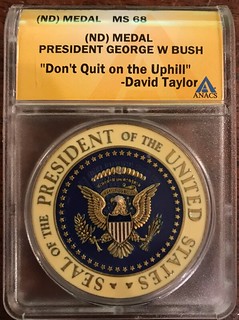
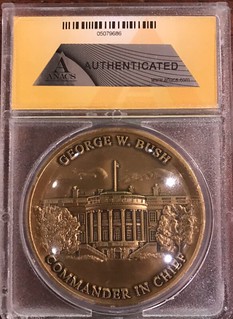
John adds:
The eulogy prepared and presented by his brother is the stuff of eulogy writing legend. It was so good that the owner of a German Deli that David used to frequent added it to his website word for word. If you’re interested, you will really get a good sense for who David was and what made him special by reading the eulogy at http://www.germandeli.com/Eulogy-for-Major-David-G-Taylor_2.
To read the earlier E-Sylum article, see:
MORE ON PRESIDENT GEORGE W. BUSH'S CHALLENGE COIN (http://www.coinbooks.org/esylum_v11n43a14.html)
ARMY CAPT. GARY ROSE RECEIVES MEDAL OF HONOR
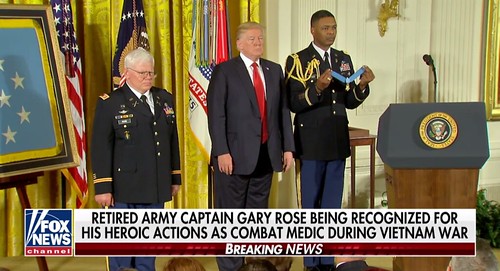
Officially retired, Army Capt. Gary “Mike” Rose was never in Laos at the height of the Vietnam War.
Rose, now 69, served as a medic in the Military Assistance Command Studies and Observations Group, an elite division of the Special Forces. It was so secret that, for more than four decades, he never spoke about it to anyone – not even the people he served with.
Those that served with him, however, never forgot the bravery he showed during a four-day mission, called “Operation Tailwind,” in the landlocked country in September 1970.
Rose, then a sergeant, ran through a hail of gunfire to treat more than 50 soldiers who were fighting the North Vietnamese Army – using one hand to hoist wounded men onto his back while he fired on the enemy with his other hand.
In spite of his own injuries, he didn’t sleep for days to make sure all 16 American soldiers deployed with him made it home.
They did.
Forty-seven years later, Rose was commemorated for his "extraordinary selfless service" on Monday when he received the Medal of Honor during a ceremony with President Trump at the White House.
The president recounted the details of Rose's time in battle before awarding him the medal, recognizing "the true American hero that he is."
Following the ceremony, Rose told reporters that he considered the award to be "a collective medal" for all of the servicemen who fought in the battle and was "convinced that they have been recognized for the great service that did to this country."
To read the complete article, see:
Army Capt. Gary Rose, risked his life to save others in
Vietnam War, awarded Medal of Honor (http://www.foxnews.com/us/2017/10/23/army-capt-gary-rose-risked-his-life-to-save-others-in-vietnam-war-to-get-medal-honor.html)
NEW £10 NOTE HAS BRAILLE-STYLE FEATURE
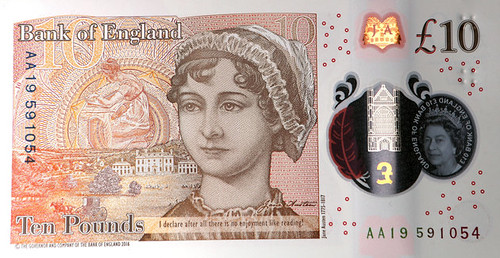
The raised dots can be seen in the top right hand side of the note
Visually impaired people have praised the new £10 note for a special feature built in to help tell notes apart.
The new polymer tenner... features raised Braille-style bumps in the top left-hand corner.
It was developed in conjunction with the Royal National Institute for the Blind (RNIB).
Ian Morris, who is partially-sighted, told HuffPost UK that he thought the new feature was “absolutely fantastic”.
He said: “It’s part of the evolution of what I’d call inclusive money, so a number of people who are sighted wouldn’t realise that the old paper notes - the five, 10 and 20, were three different lengths. So if you had a reference note, say you knew you definitely had a £10 note, then the fiver was slightly shorter and the twenty was slightly longer. But you basically had to stand there and line up edges and feel along the note.
“When the new £5 note came out then for me that was splendid. It was much smaller, very tactilely different. So it was very easy for you to organise your wallet in terms of ‘that’s a fiver and that’s not’. So I was very interested to see what the new £10 note felt like.”
The new £10 note, which features author Jane Austen, also includes bold numerals, differing colours and tiered sizing to further help partially-sighted and blind people, according to Optometry Today.
To read the complete article, see:
New £10 Note Feature For Visually Impaired People Praised As 'Absolutely
Fantastic' (http://www.huffingtonpost.co.uk/entry/new-10-note-release-date-blind_uk_59b65b18e4b0354e4412e2a7)
CANADA $20 BILL'S MAPLE LEAF ISN’T CANADIAN
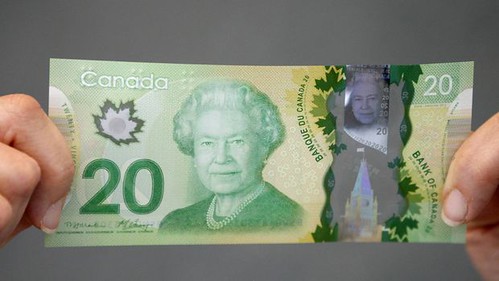
Canada's new polymer $20 bills have been rapped for melting and not working in vending machines.
Now, botanists say one of the maple leaves on the note shows a Norway maple, which is not native to Canada.
"It's rather sad. It's not the first time that it's happened," said Julian Starr, a botany professor at the University of Ottawa who specializes in plant identification and classification. "It's almost Canadian in the fact that we can't even get our symbols right."
However, the Bank of Canada, which makes bank notes, says the $20 bill does not depict a Norway maple leaf, but rather a "stylized" design.
Prof. Starr, who has previously consulted for the Royal Canadian Mint, says there is no doubt that the leaf – which appears above the "20" – is from a Norway maple tree. It has five main lobes, or projections from the body of the leaf, and the tips are stringy. On the other hand, sugar maple leaves have just three lobes and the tips aren't stringy.
Norway maple trees, which are considered invasive in North America and have been banned in two states, are native to Europe and were introduced to North America in the mid-1800s. Canada has 10 native maple species.
As part of his classes, Prof. Starr chronicles a list of official botany errors, including on the penny and in the logos for the former Canadian Television Fund and the 2007 FIFA under-20 World Cup of soccer, which was held in Canada. The penny, he said, appears to show leaves from the plane tree rather than a maple tree. The coin's two leaves emerge from different parts of the stem, rather than being directly opposite each other, which is the case for maple trees.
To read the complete article, see:
$20 bill’s maple leaf isn’t Canadian, botanists say
(https://beta.theglobeandmail.com/news/national/20-bills-maple-leaf-isnt-canadian-botanists-say/article7519375/)
WOULD BREAKAWAY CATALONIA CREATE OWN CURRENCY?
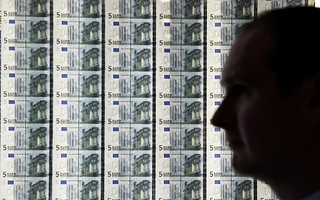 The Catalan independence vote has drawn parallels with the Greek crisis of 2015 - including speculation the region could form its own currency.
The Catalan independence vote has drawn parallels with the Greek crisis of 2015 - including speculation the region could form its own currency.
During the upheaval in Greece in the summer of 2015, the spectre of a 'Grexit' was on the horizon that would have entailed it withdrawing from the eurozone.
Even before Greeks voted in a referendum against the deal laid out by its creditors, preparations were already under way to prepare for this by creating a new currency, a version of its old drachma.
In an echo of the Grexit crisis, the Catalan Government is planning contingencies so that it can go it alone, separate from the Spanish banking system. But its preparations make it different from Greece's moment because the Catalans could be looking to set up a cryptocurrency.
To read the complete article, see:
Here's how Catalonia would go about creating its own currency
(http://www.telegraph.co.uk/business/2017/10/30/would-catalonia-go-creating-currency/)
KING MIDAS STATUE COVERED IN COINS
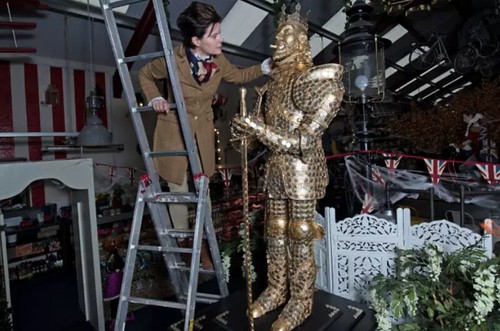
An eye-catching statue of the cursed King Midas has been created from thousands of new £1 coins.
The larger-than-life gold-coloured model required 2,000 shiny and un-circulated pounds which were then stuck with industrial glue all over the artwork.
The king’s crown also needed 40 £2 coins, which had to be dipped in cola and rubbed down in order to clean them up.
It is the latest sculpture to adorn the British Ironwork Centre in Oswestry, Shropshire, which also houses the Knife Angel, created from blades handed in to police forces during amnesties.
King Midas’ legend is a cautionary tale about the hazards of loving money, when he unwittingly transforms his daughter into solid gold.
The statue’s creator Debbie Rees-Deacon, who was commissioned by centre chairman Clive Knowles, said she wanted to provoke people into thinking about the real value of money, as both a blessing and a curse.
She said Midas’ legend had “timeless appeal” and she loved watching people’s reactions to the sculpture.
Mrs Rees-Deacon, originally from Wrexham in north Wales, said: “Money will always be something of great interest to people, for all sorts of reasons.
To read the complete article, see:
Statue of King Midas adorned with thousands of £1 coins
(http://www.scotsman.com/news/statue-of-king-midas-adorned-with-thousands-of-1-coins-1-4601289)
FEATURED WEB SITE: ROYAL MINT MUSEUM
This week's Featured Web Site is the The Royal Mint Museum in Llantrisant.The Royal Mint Museum has one of the finest collections of coins and related material in the world.
It is a collection about how money is made and how the Royal Mint has evolved over the last 1100 years.

http://www.royalmintmuseum.org.uk/

